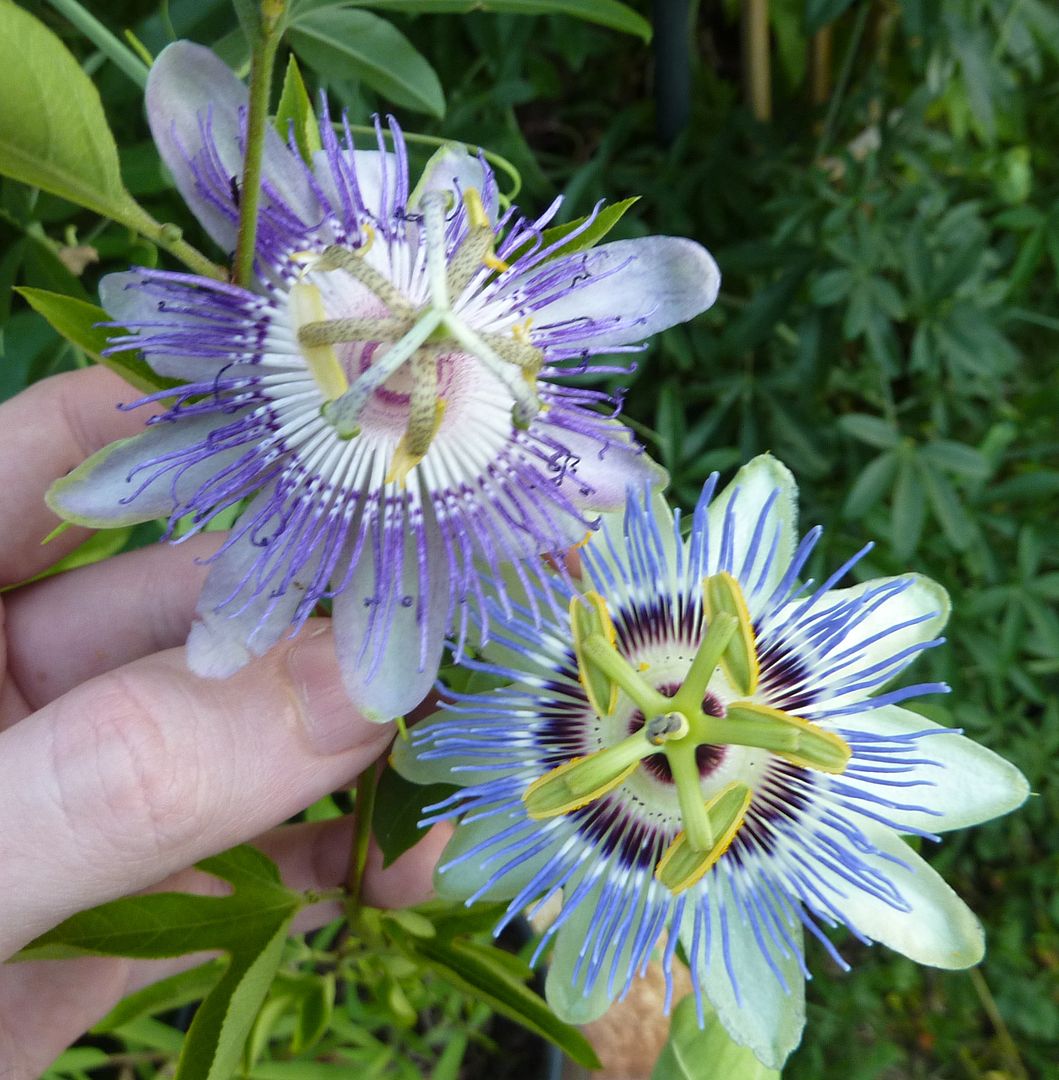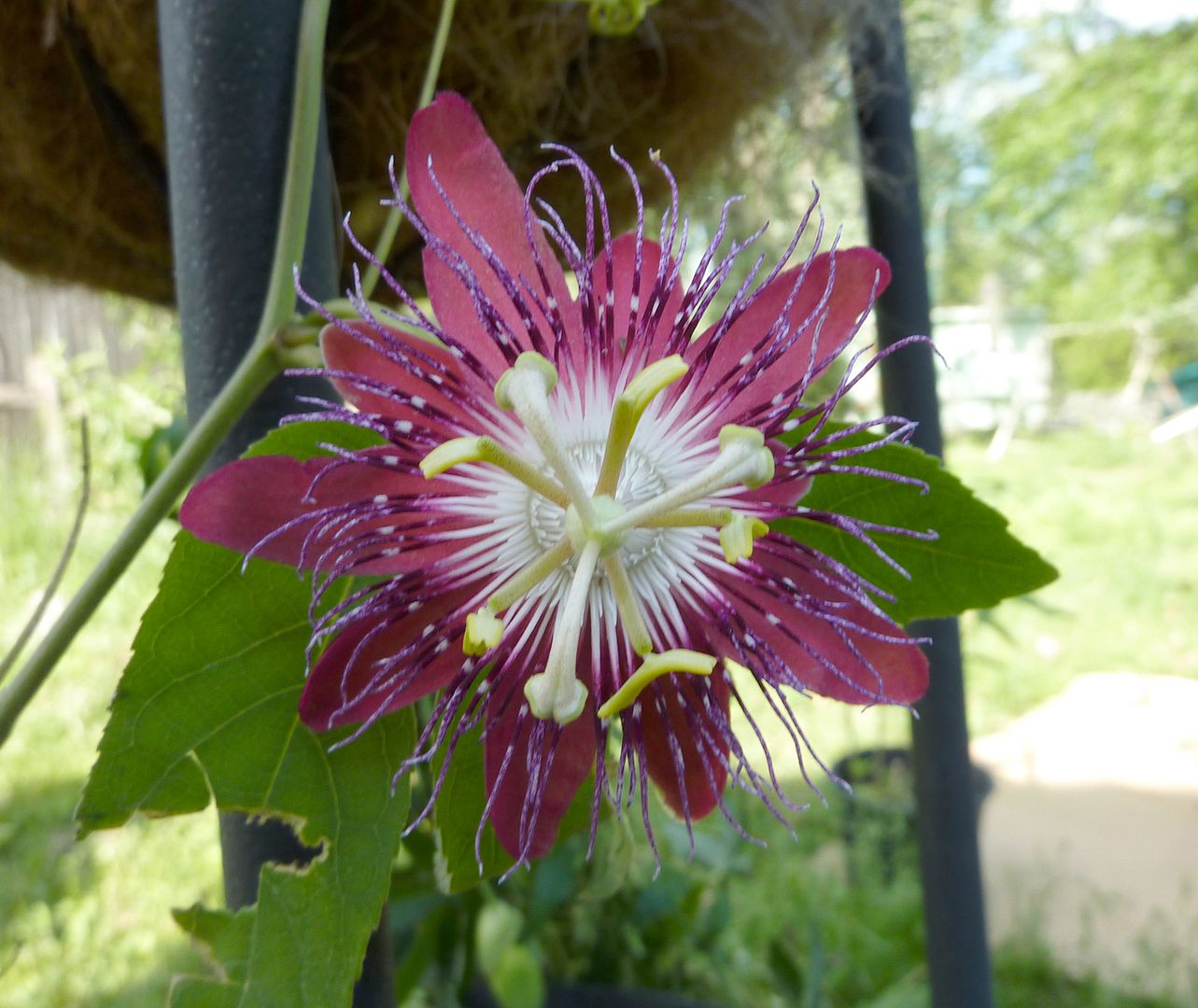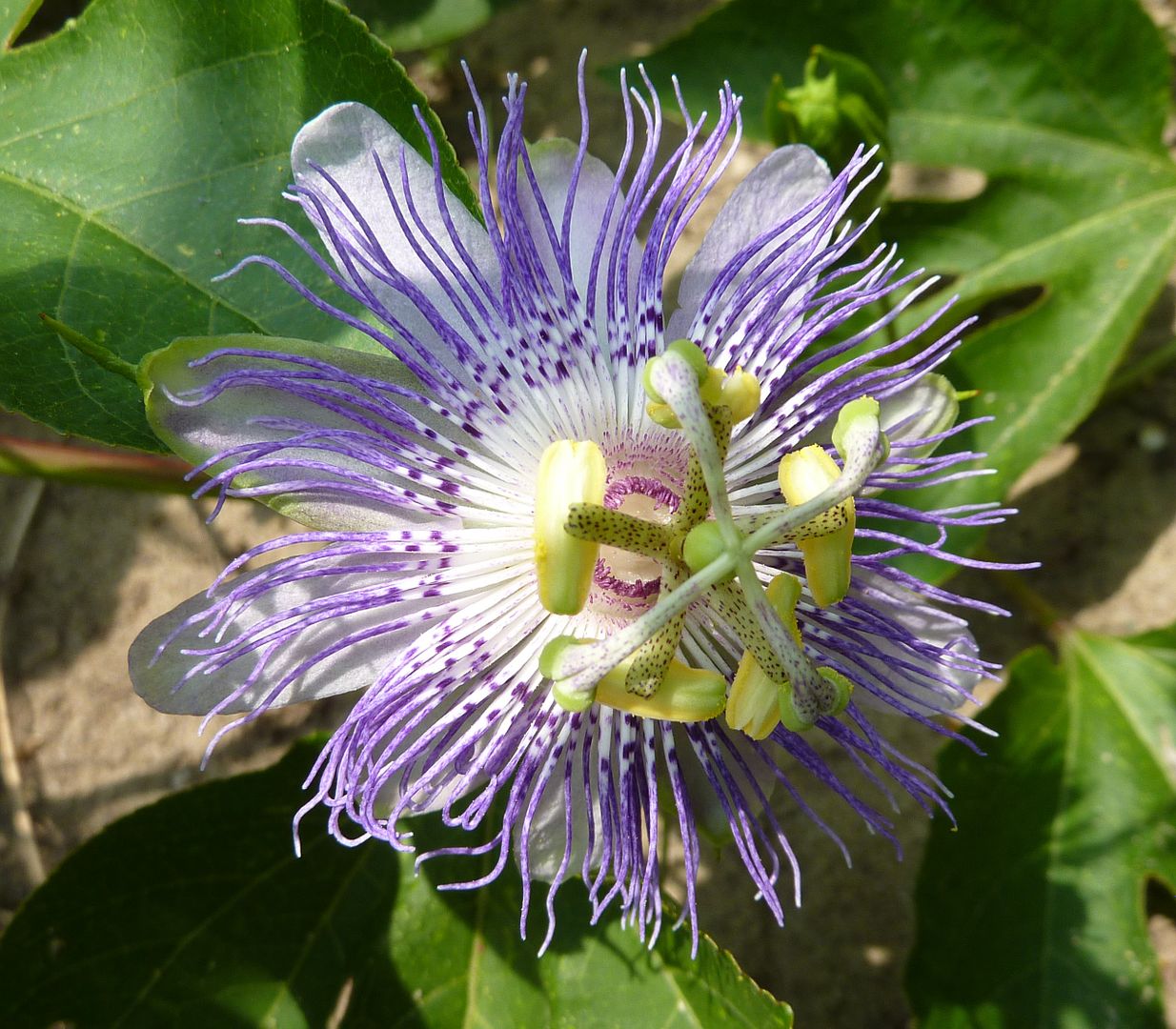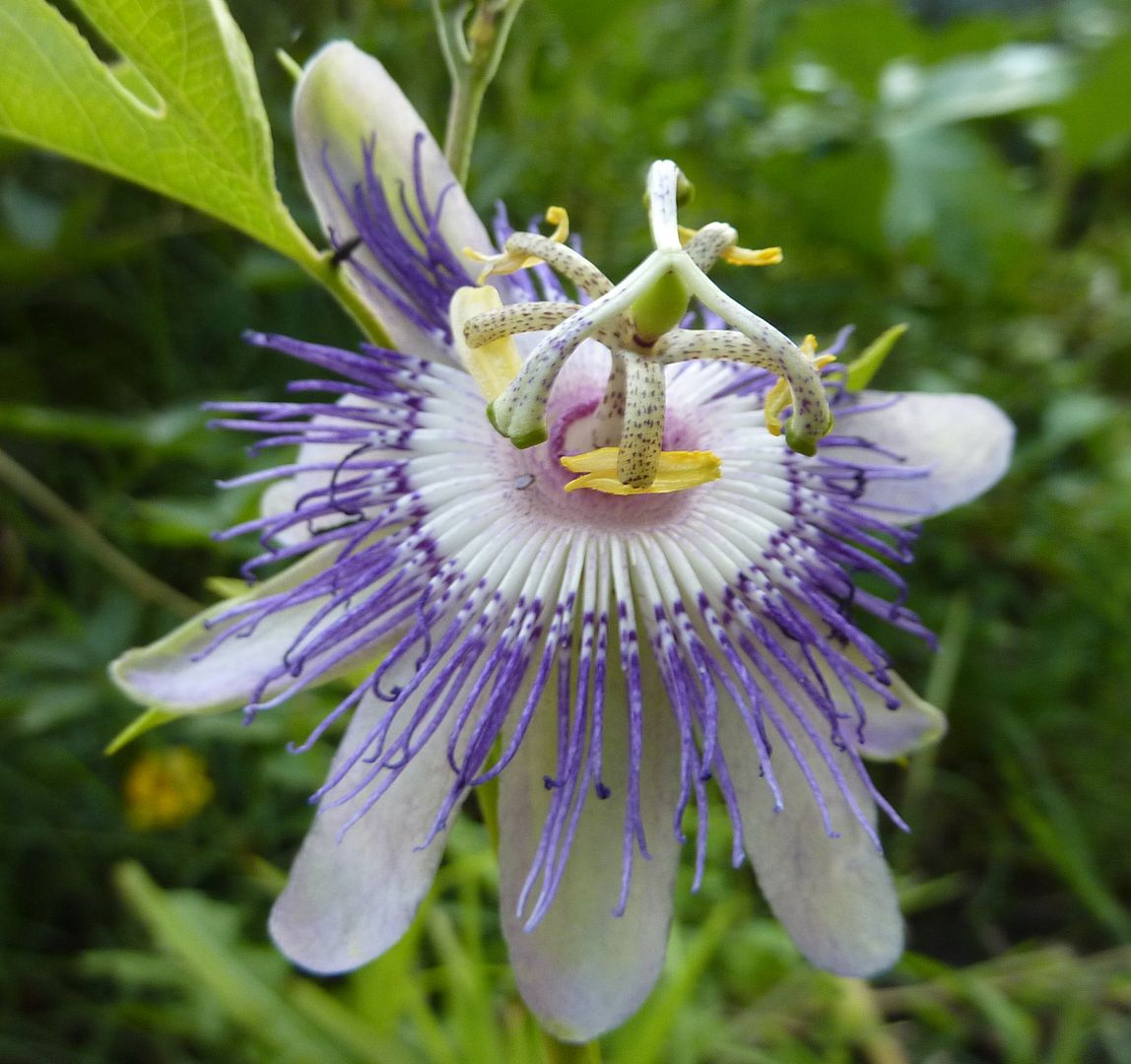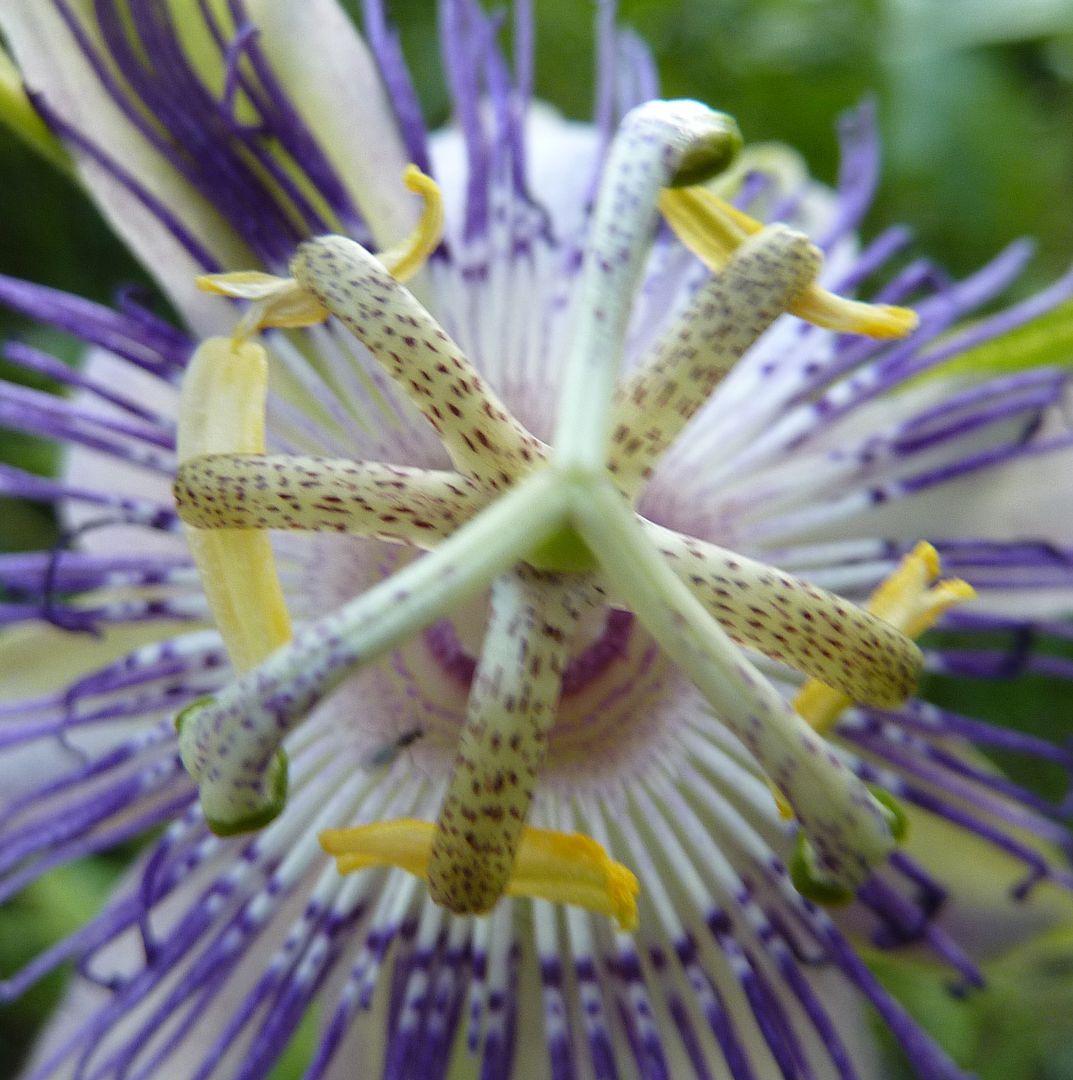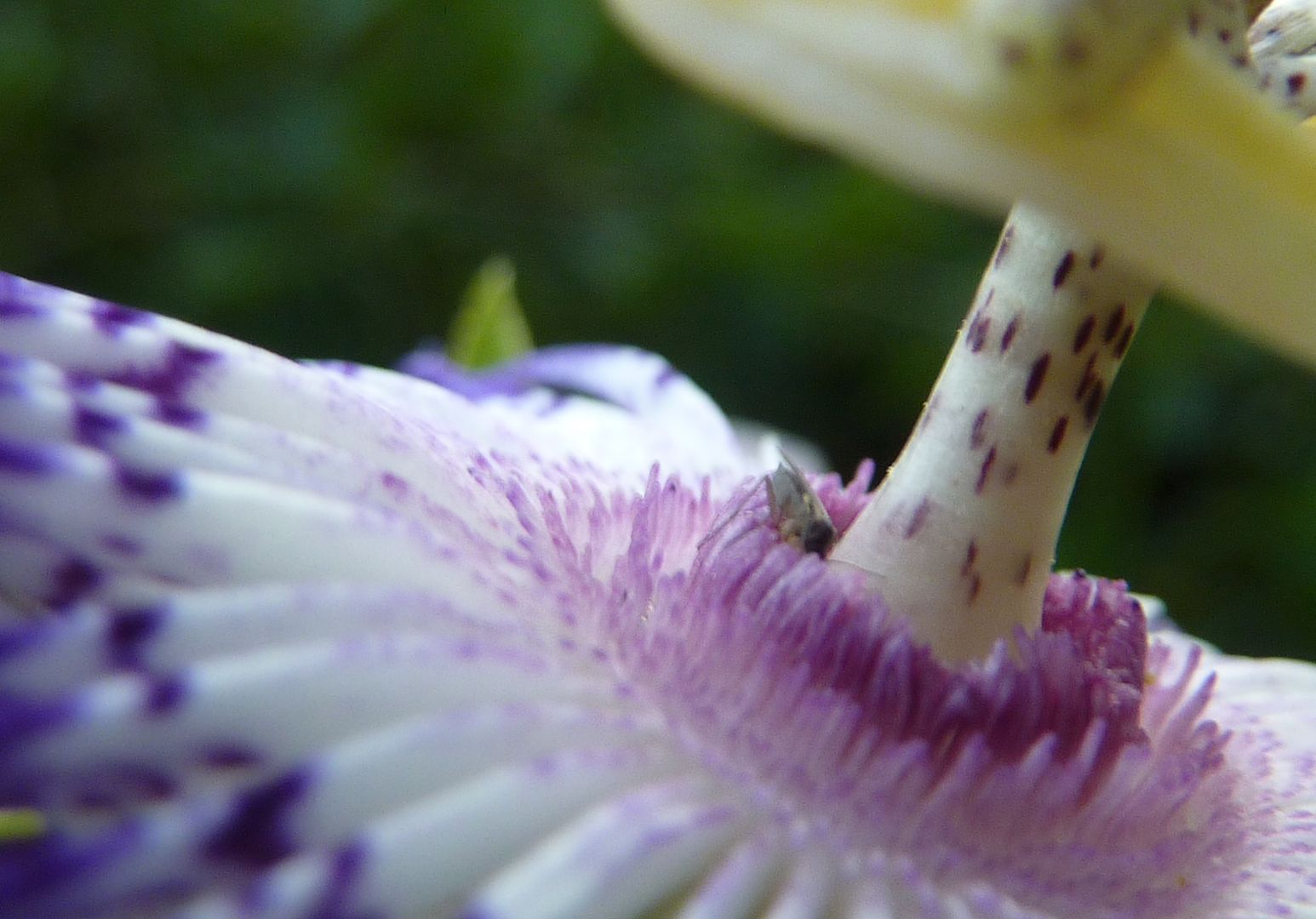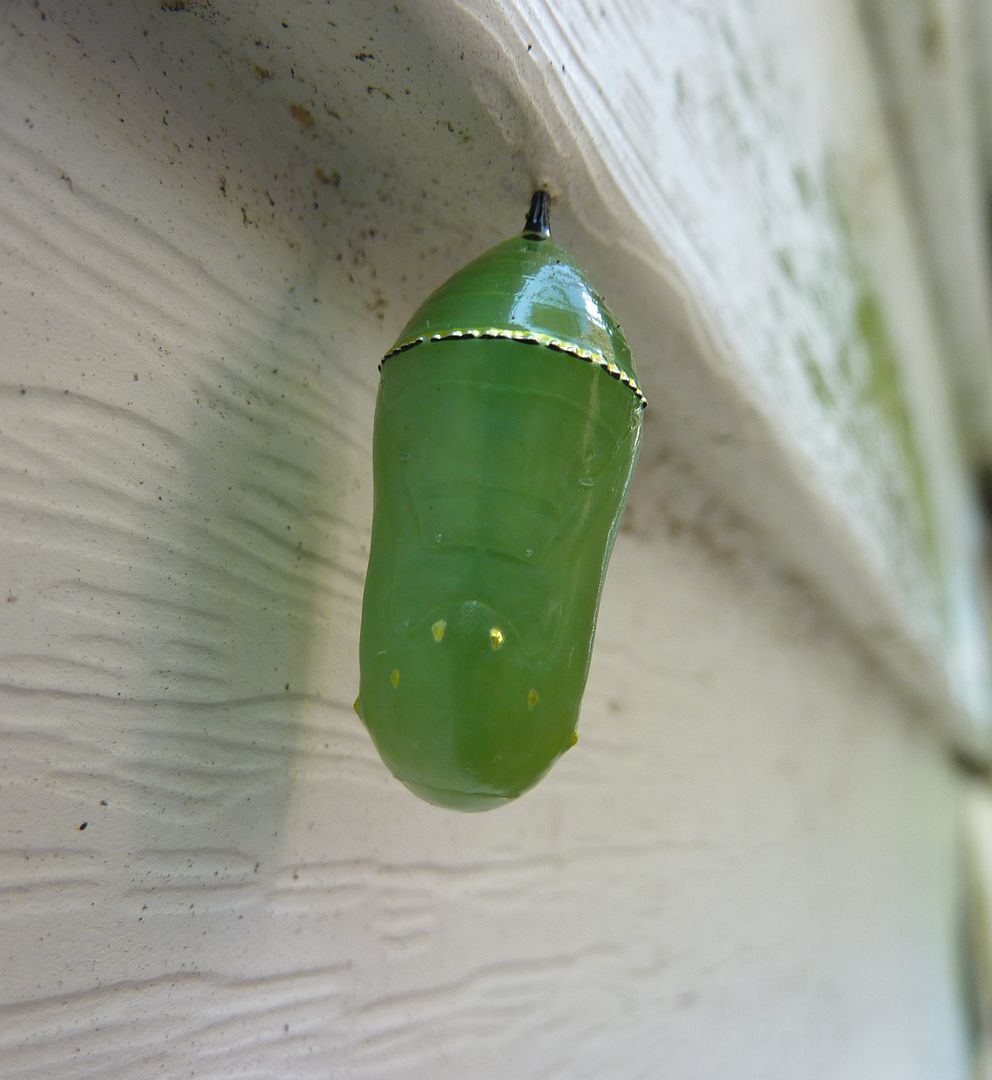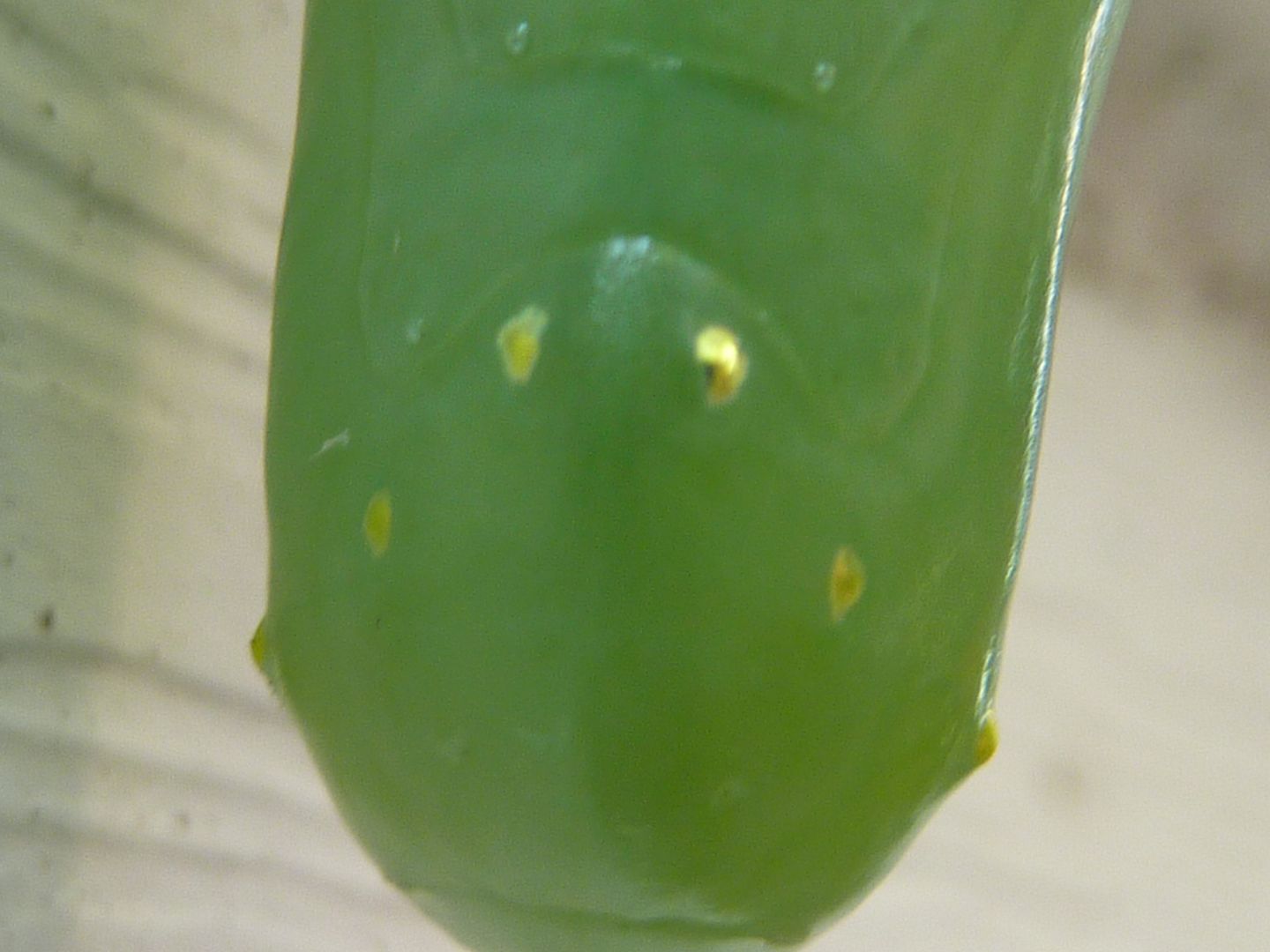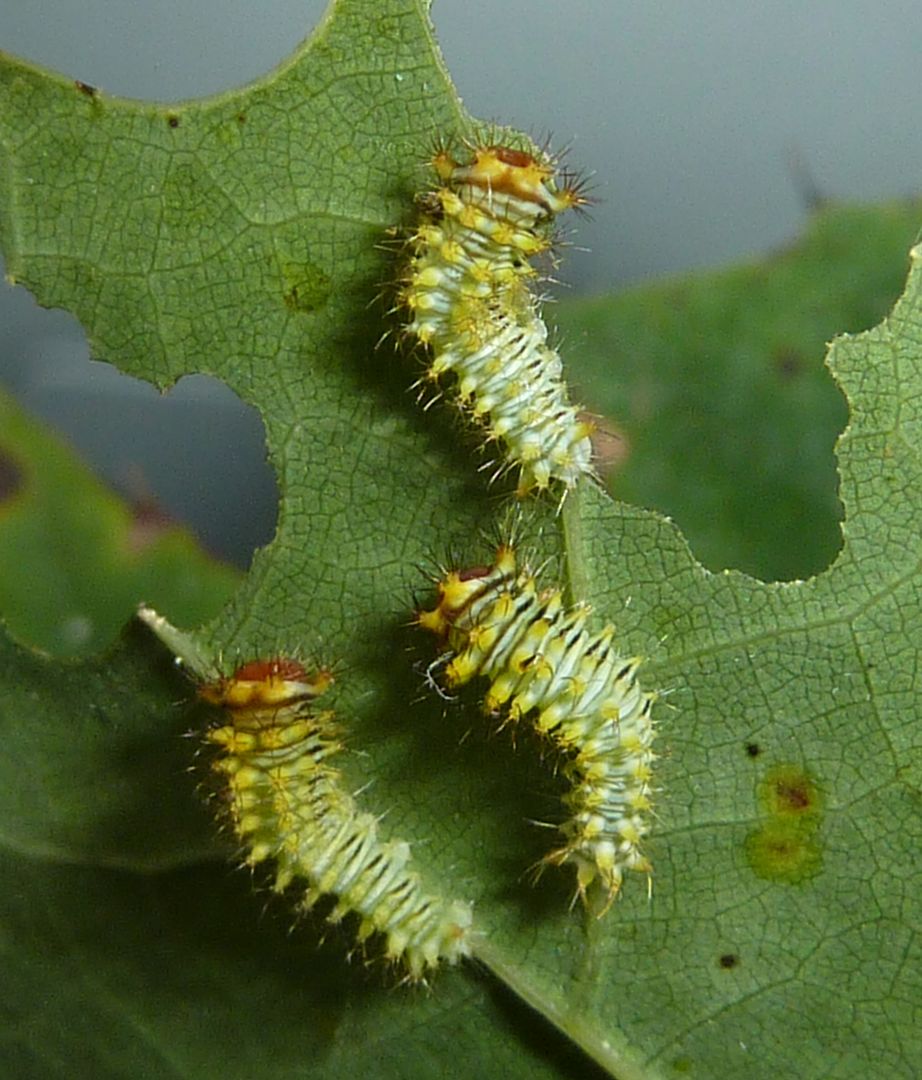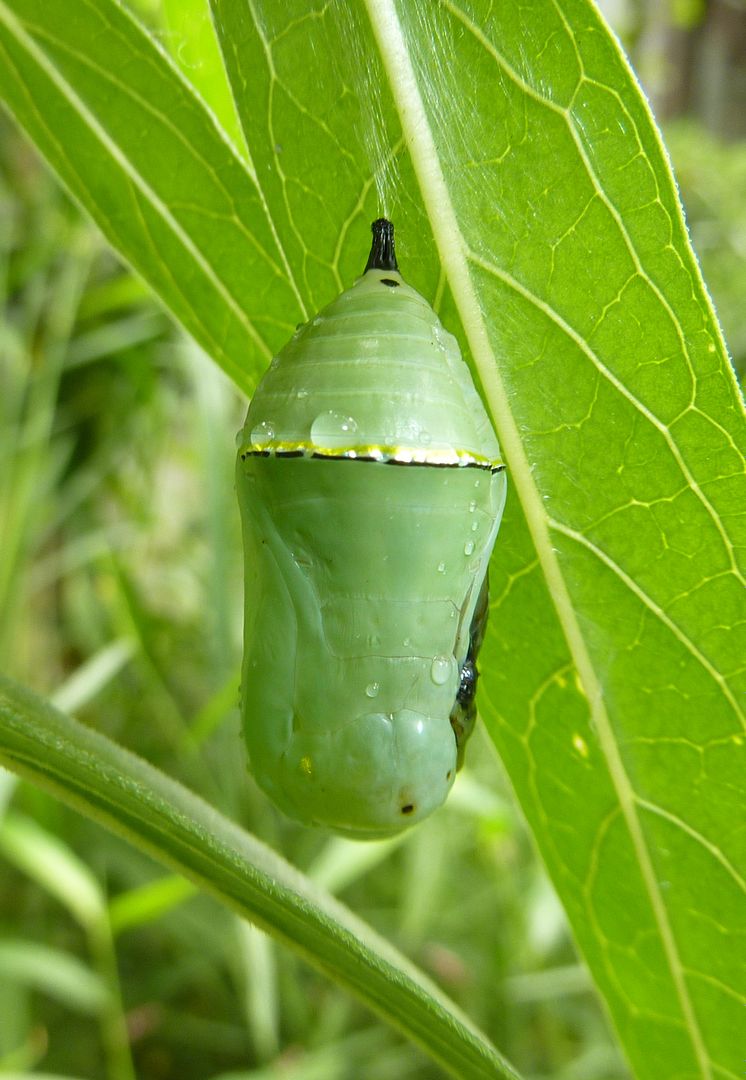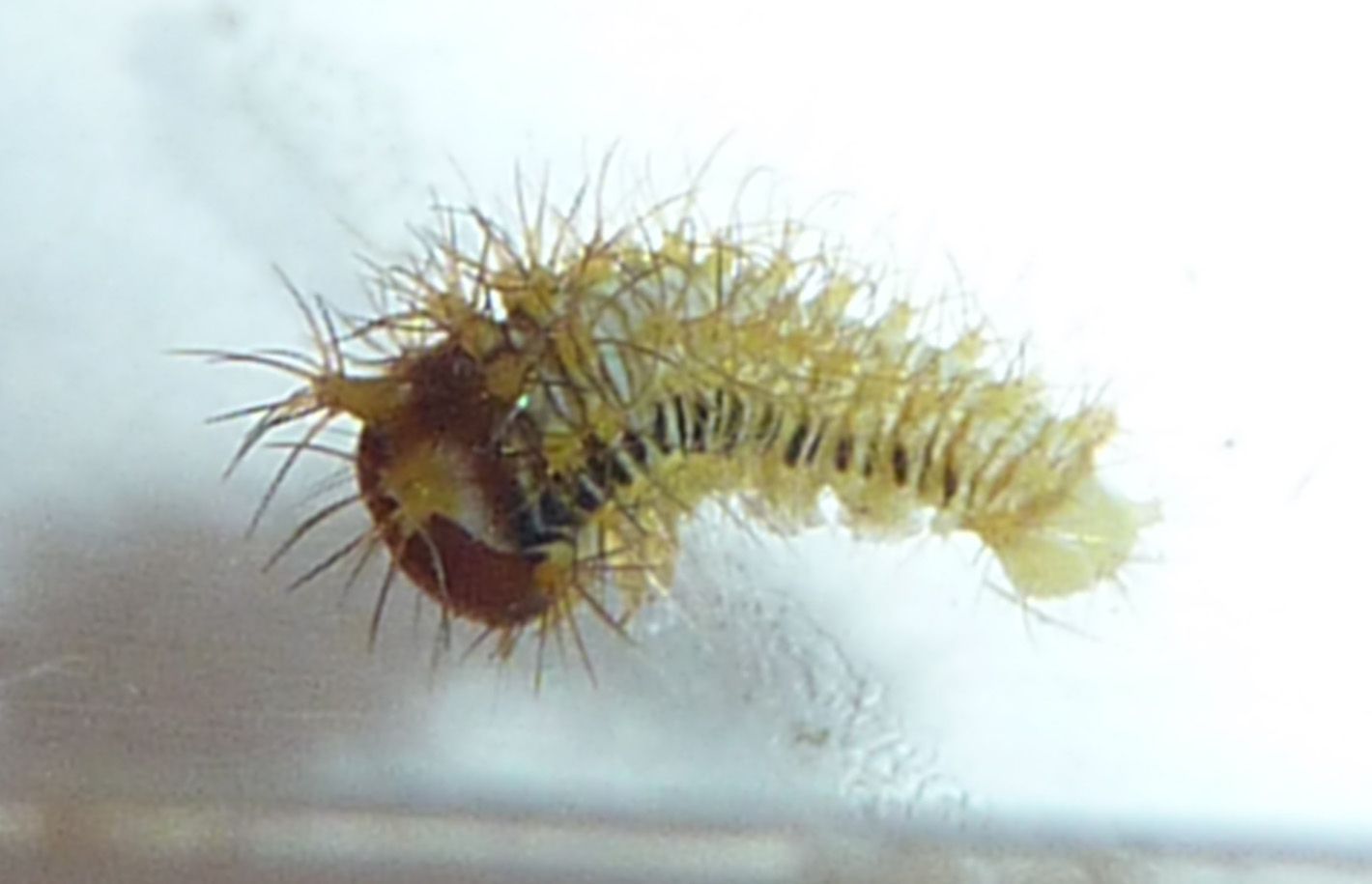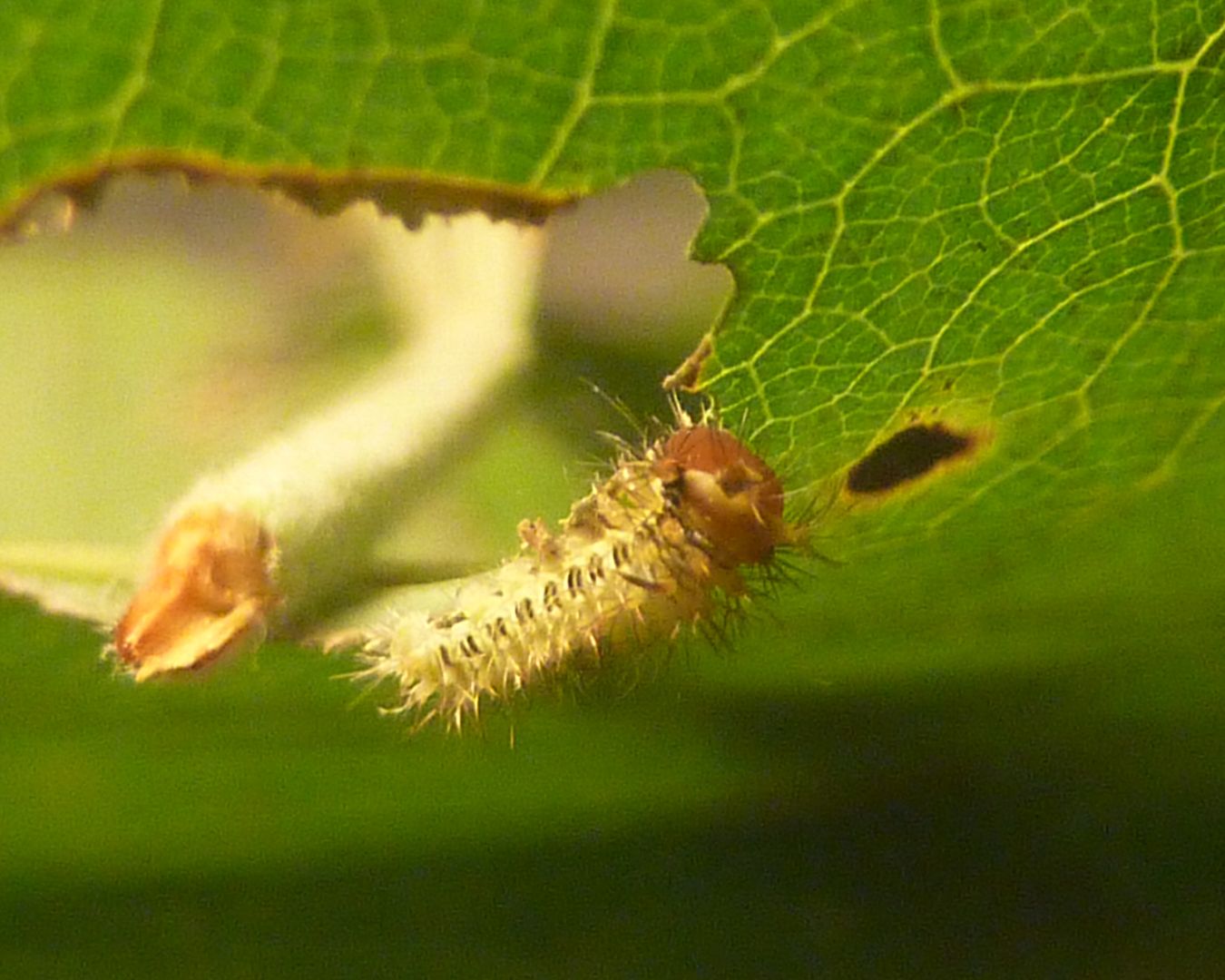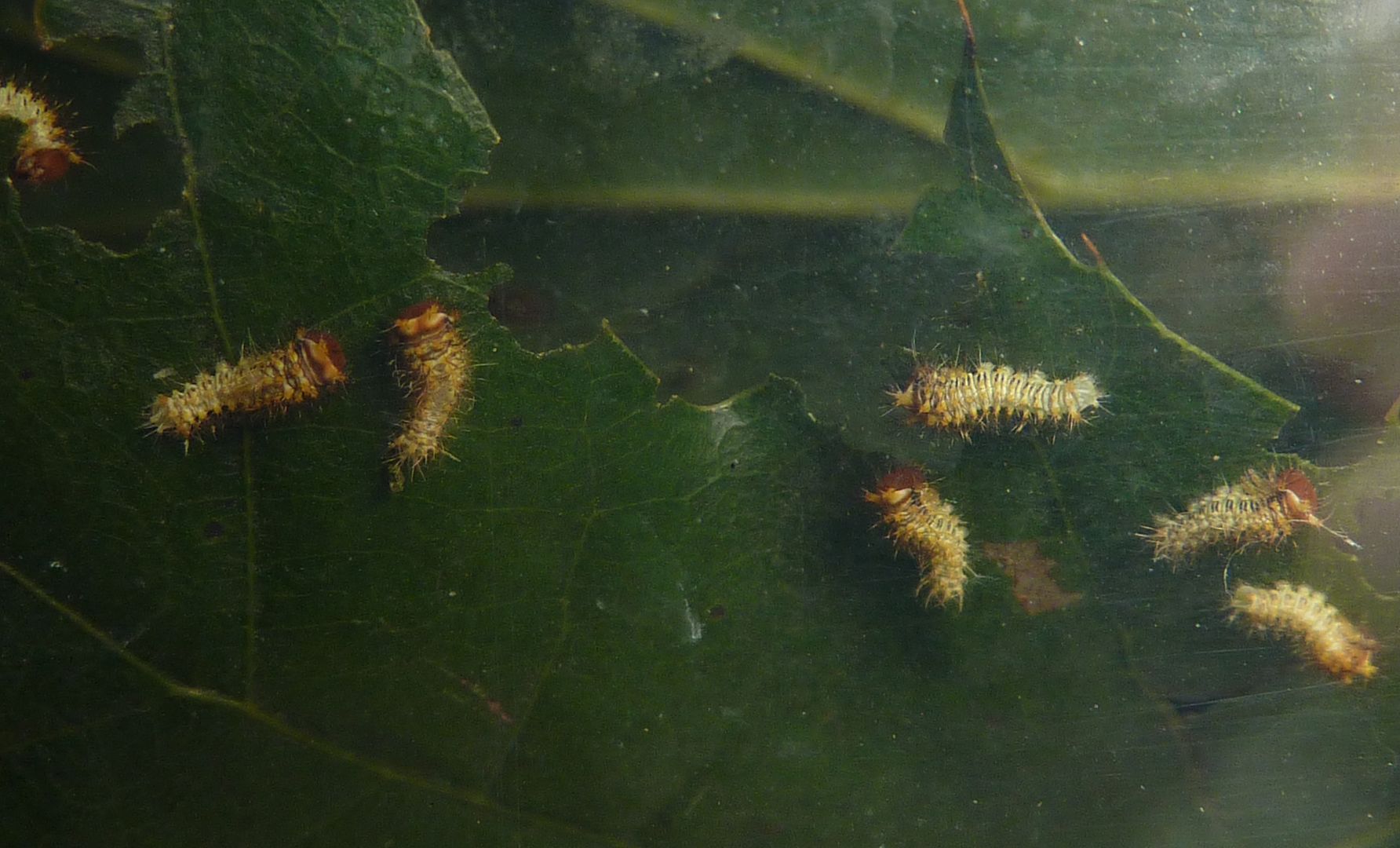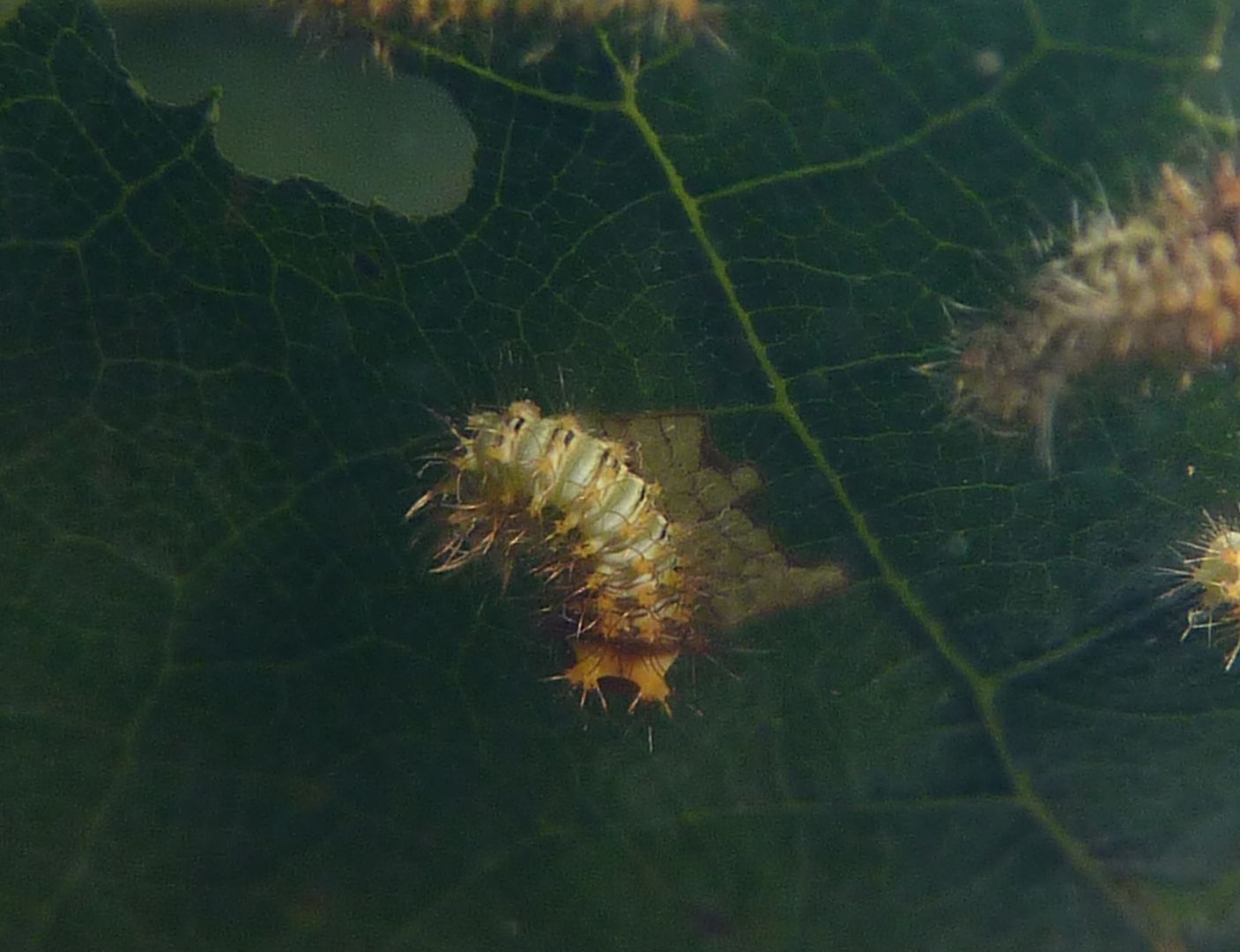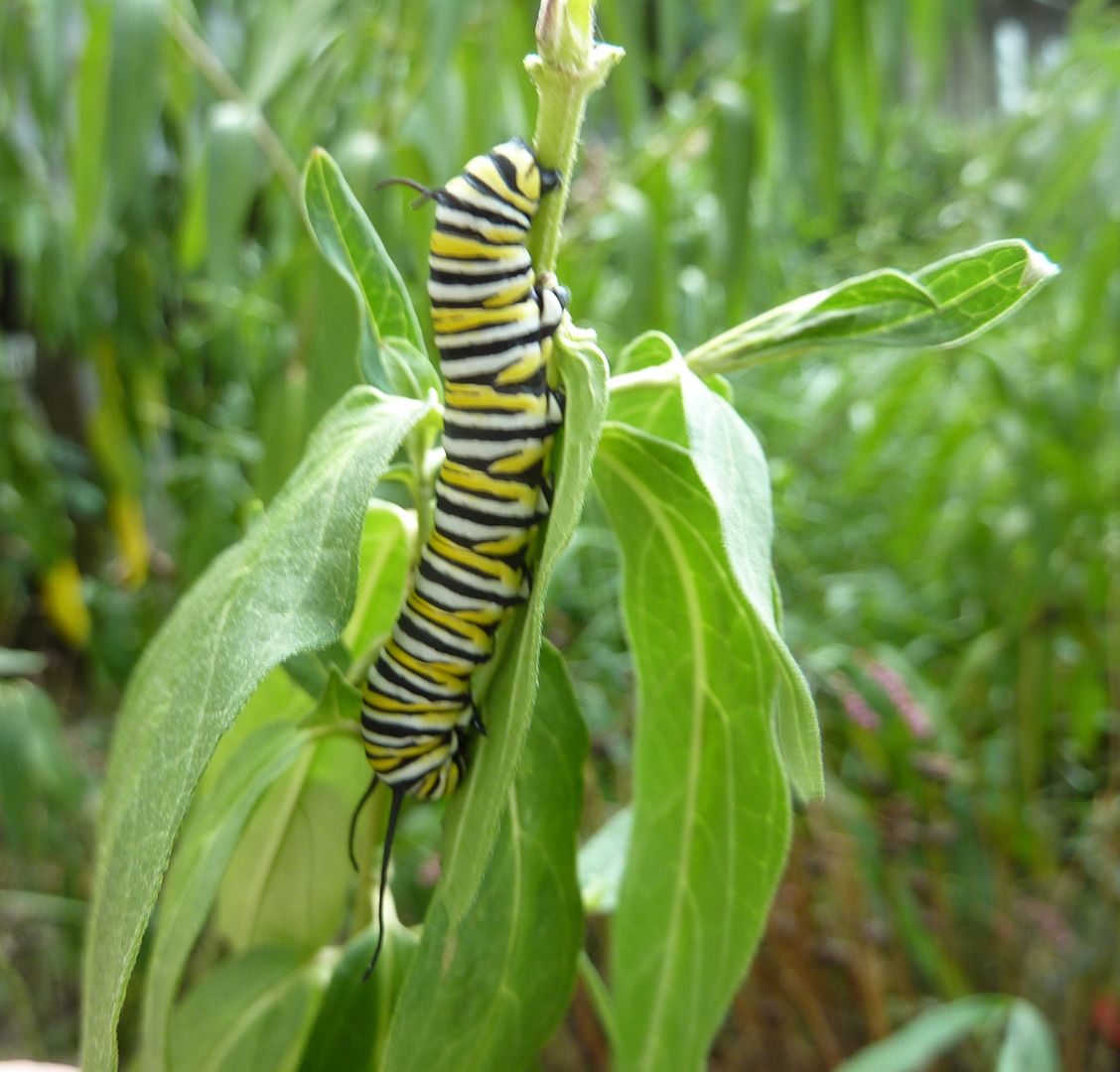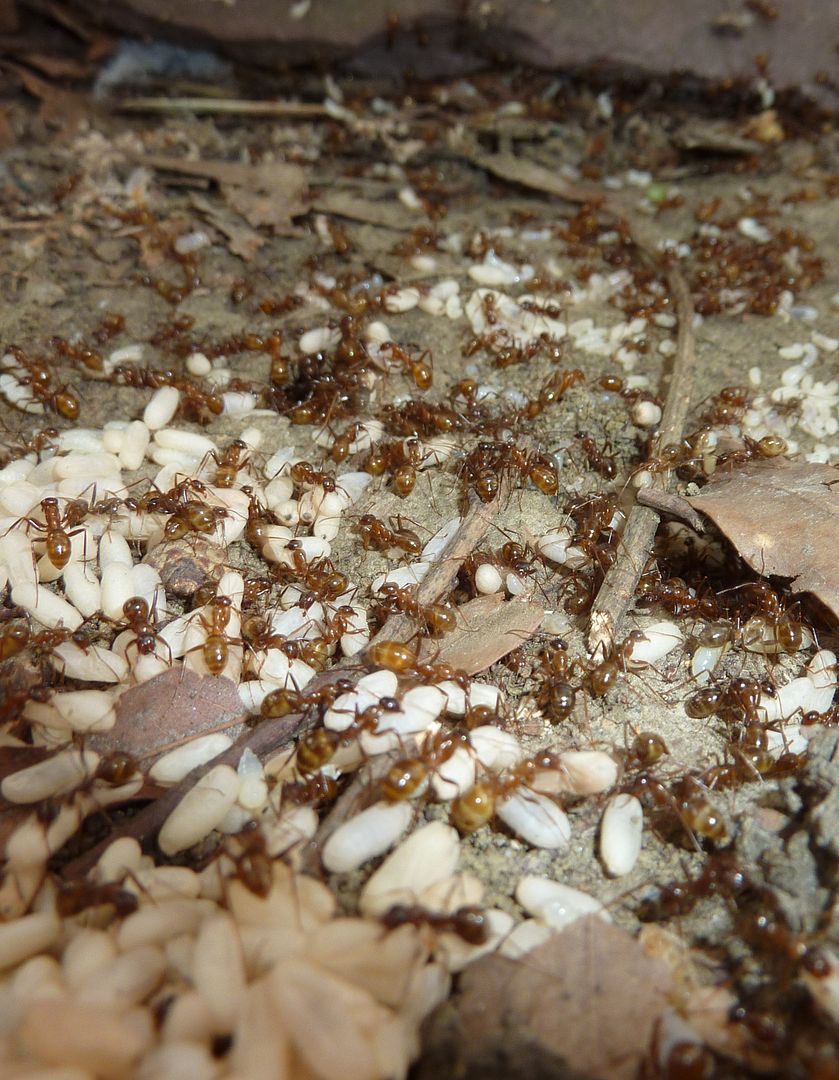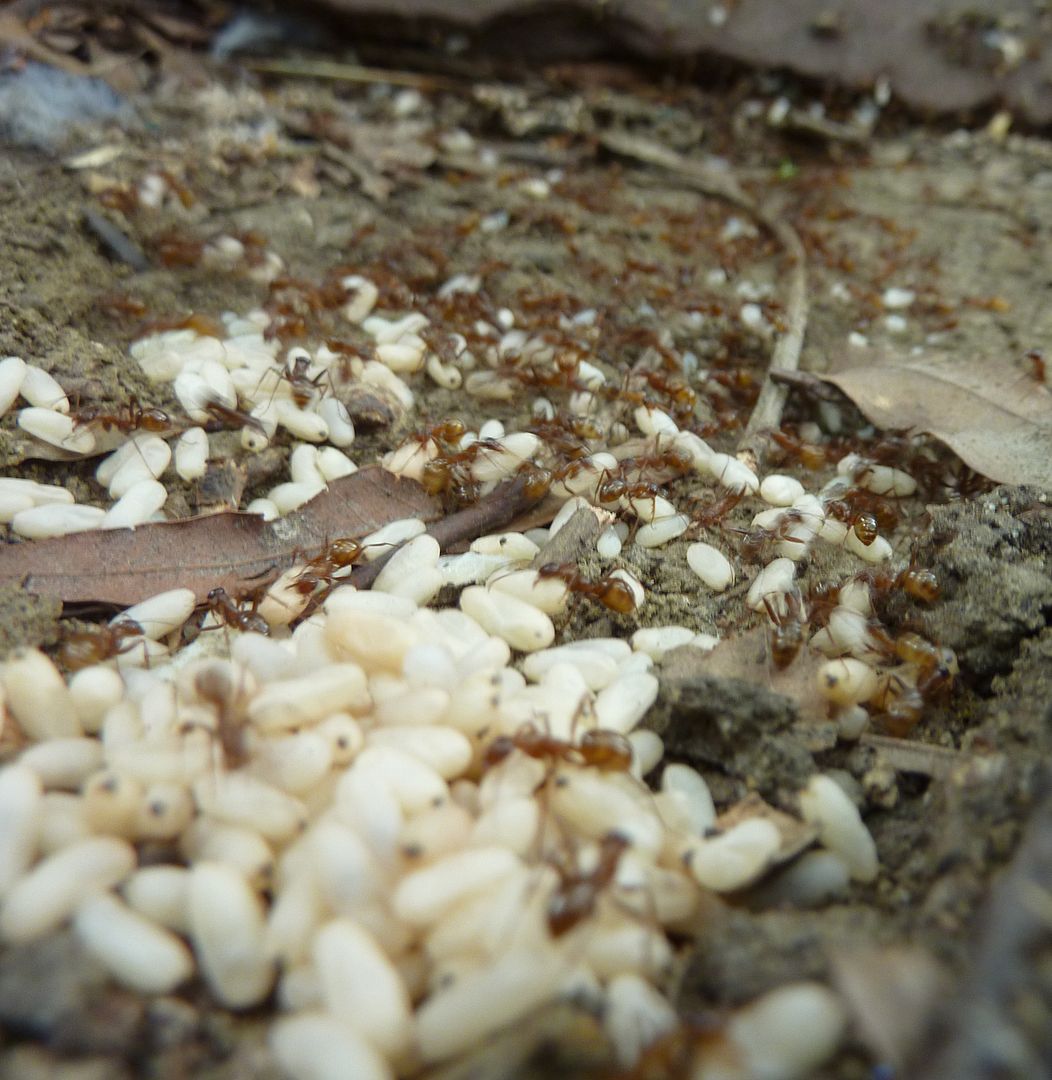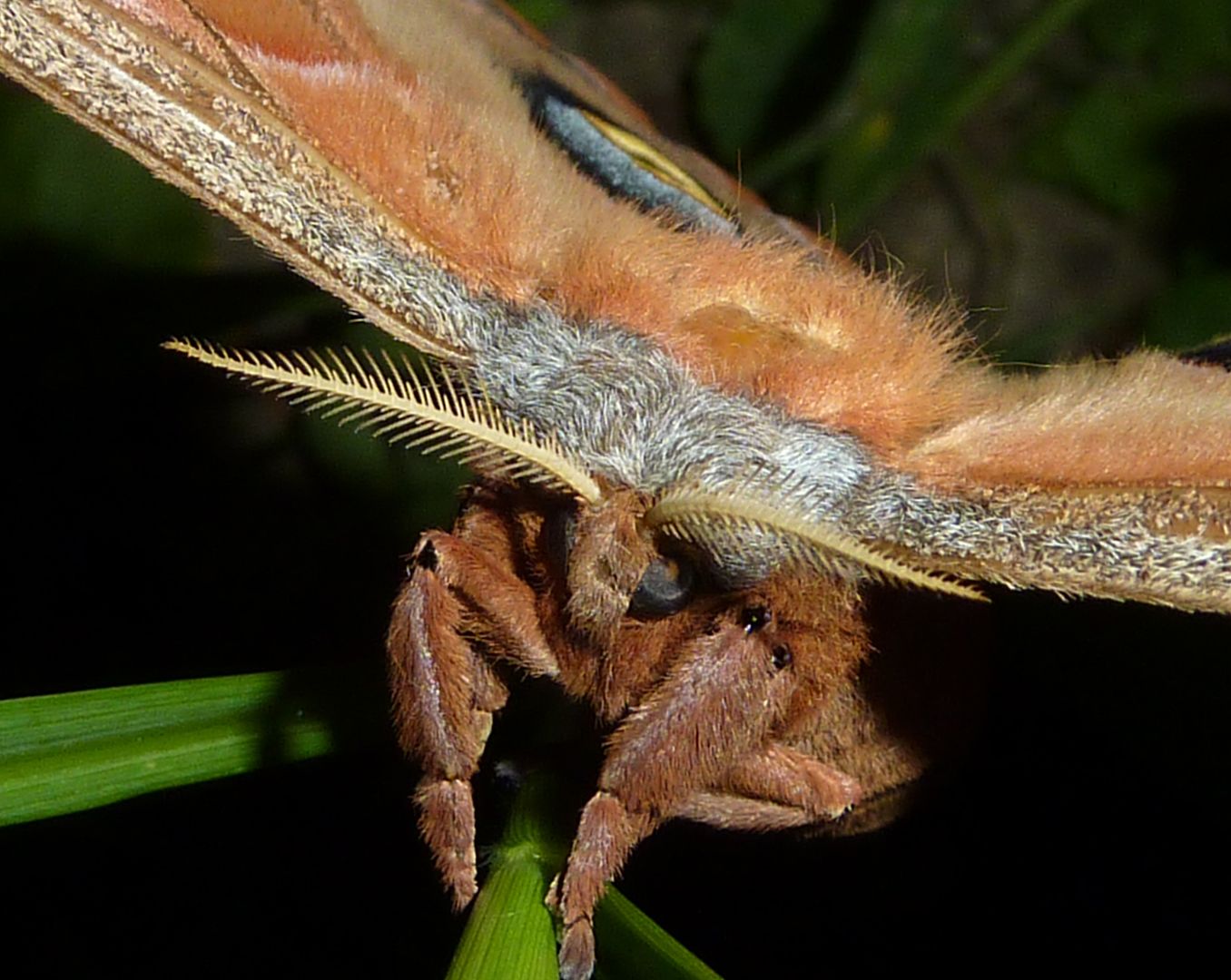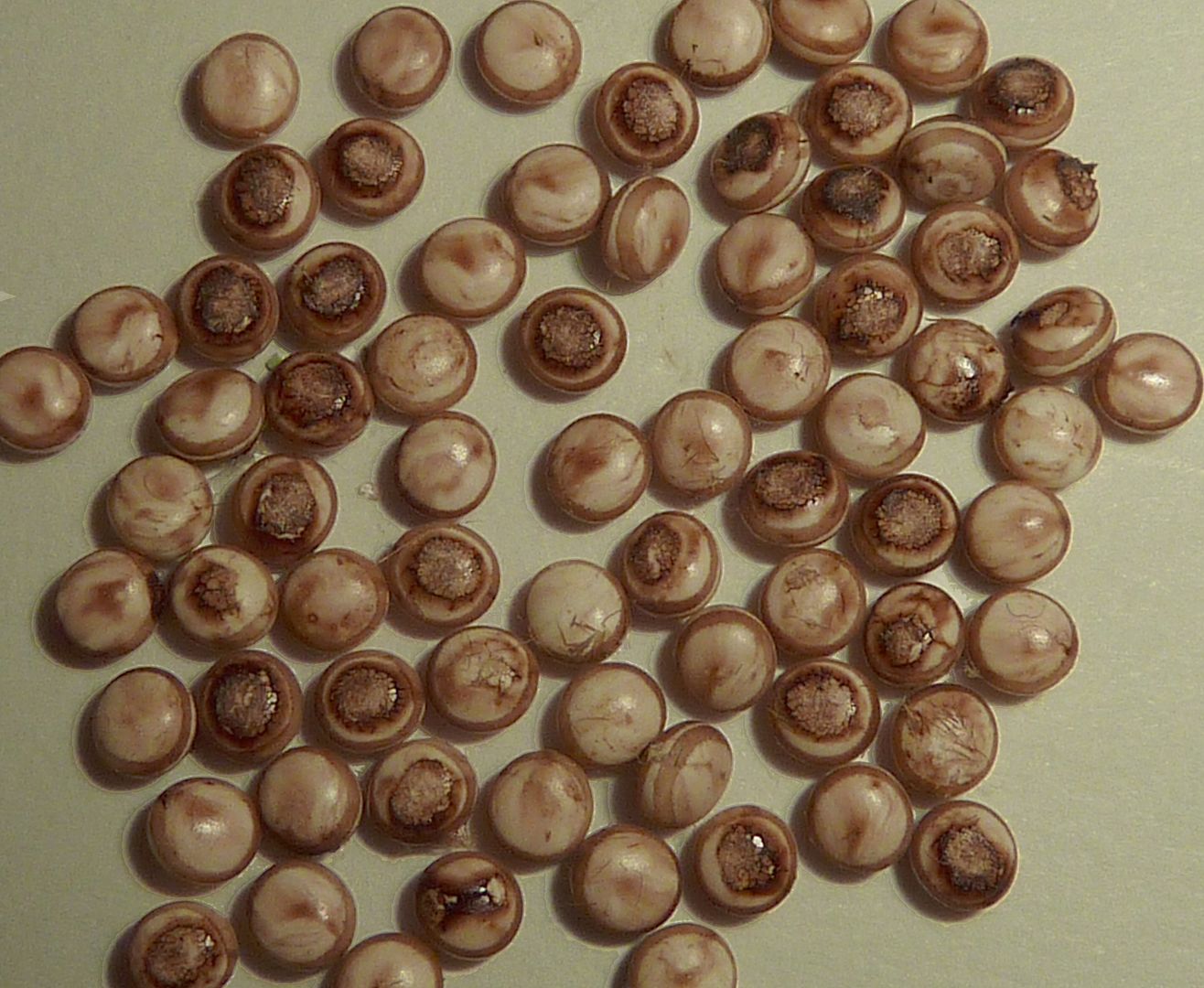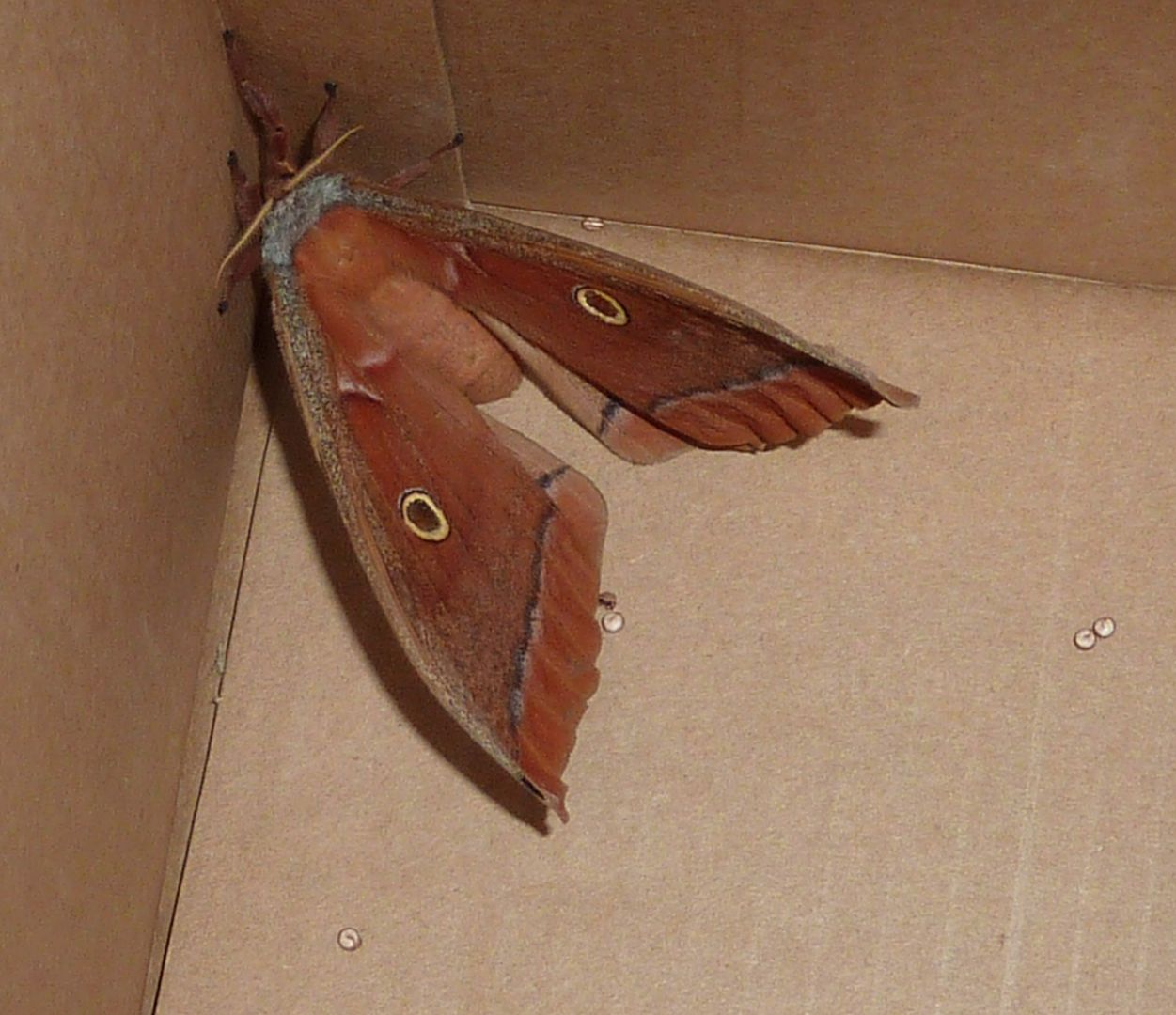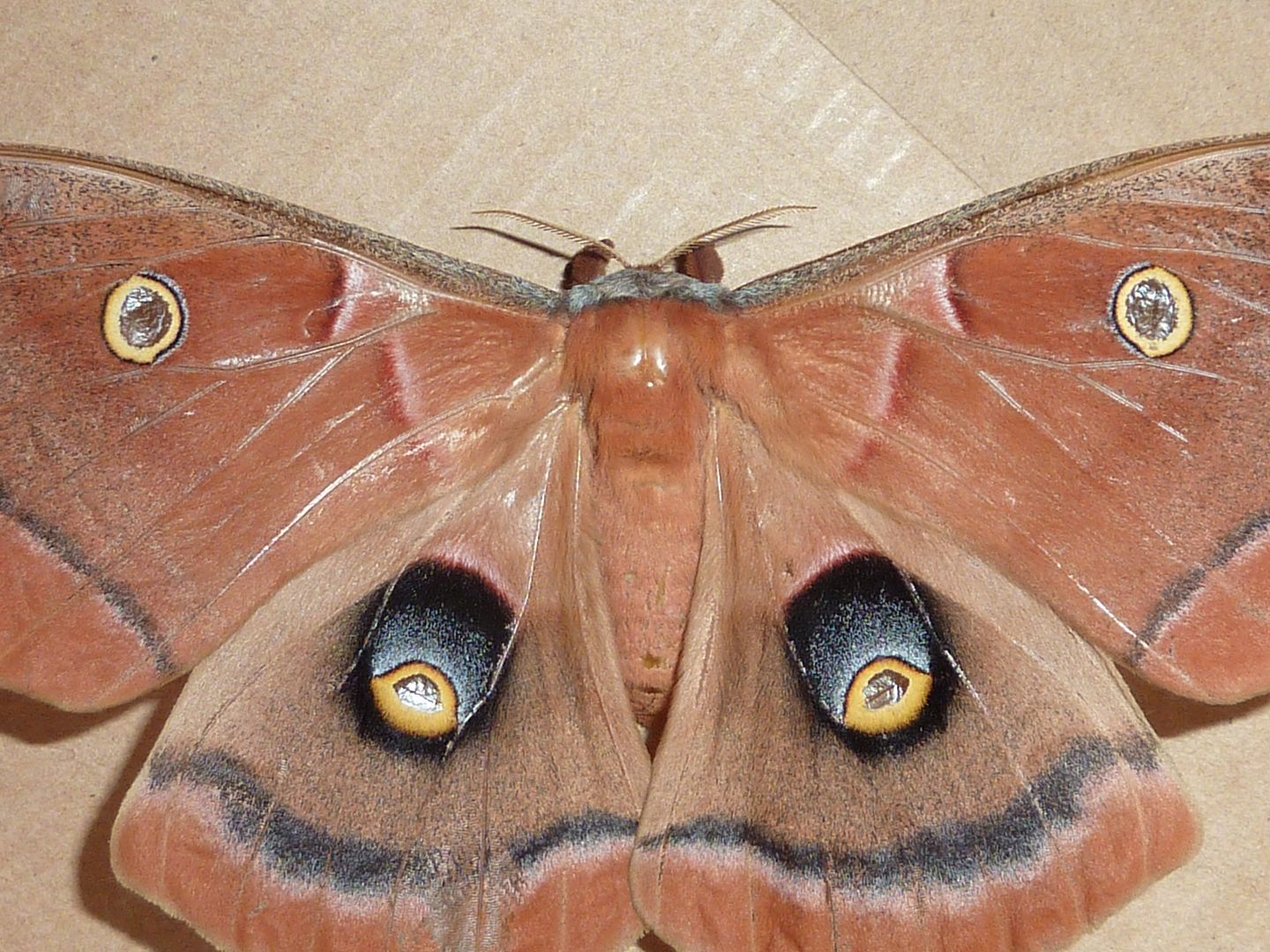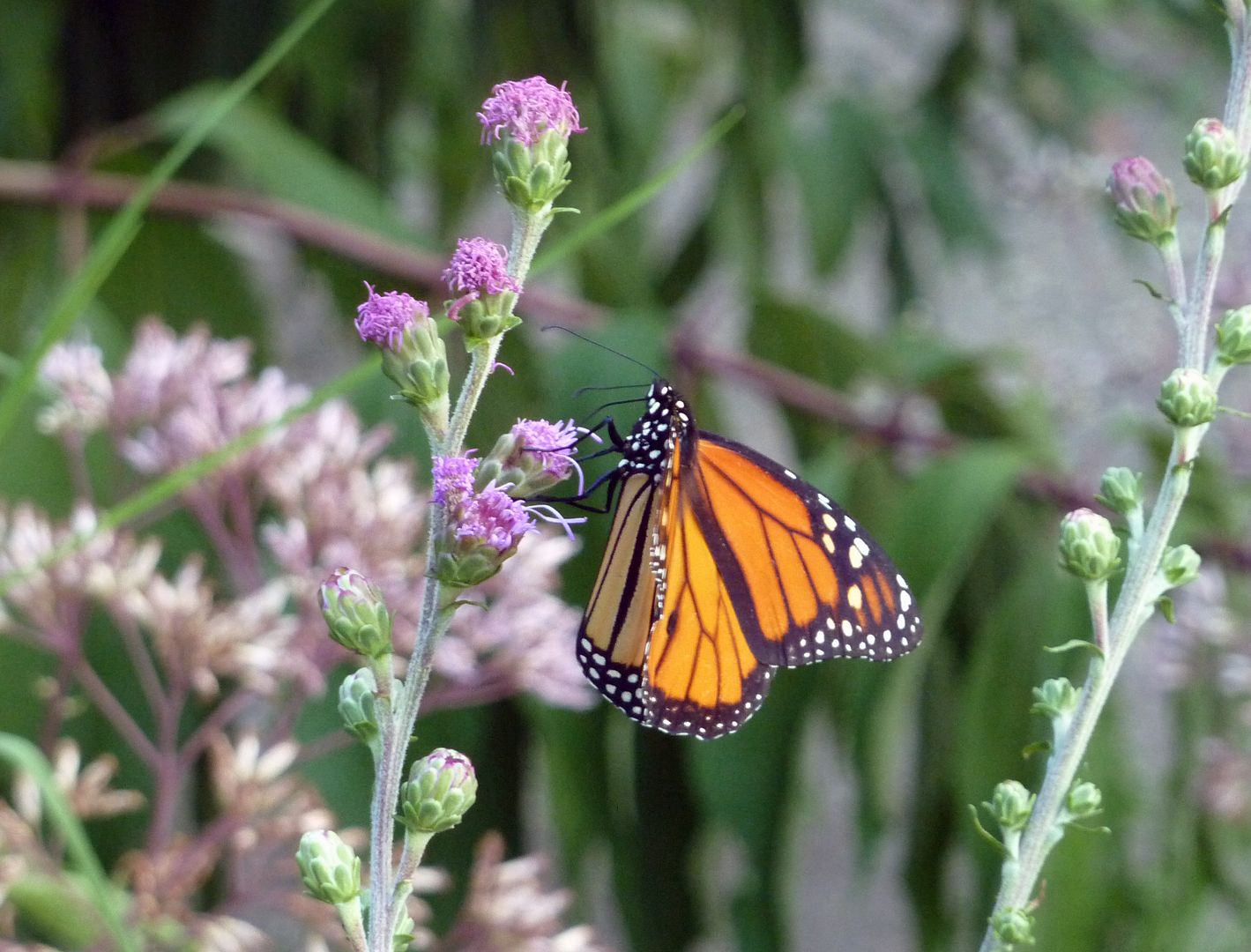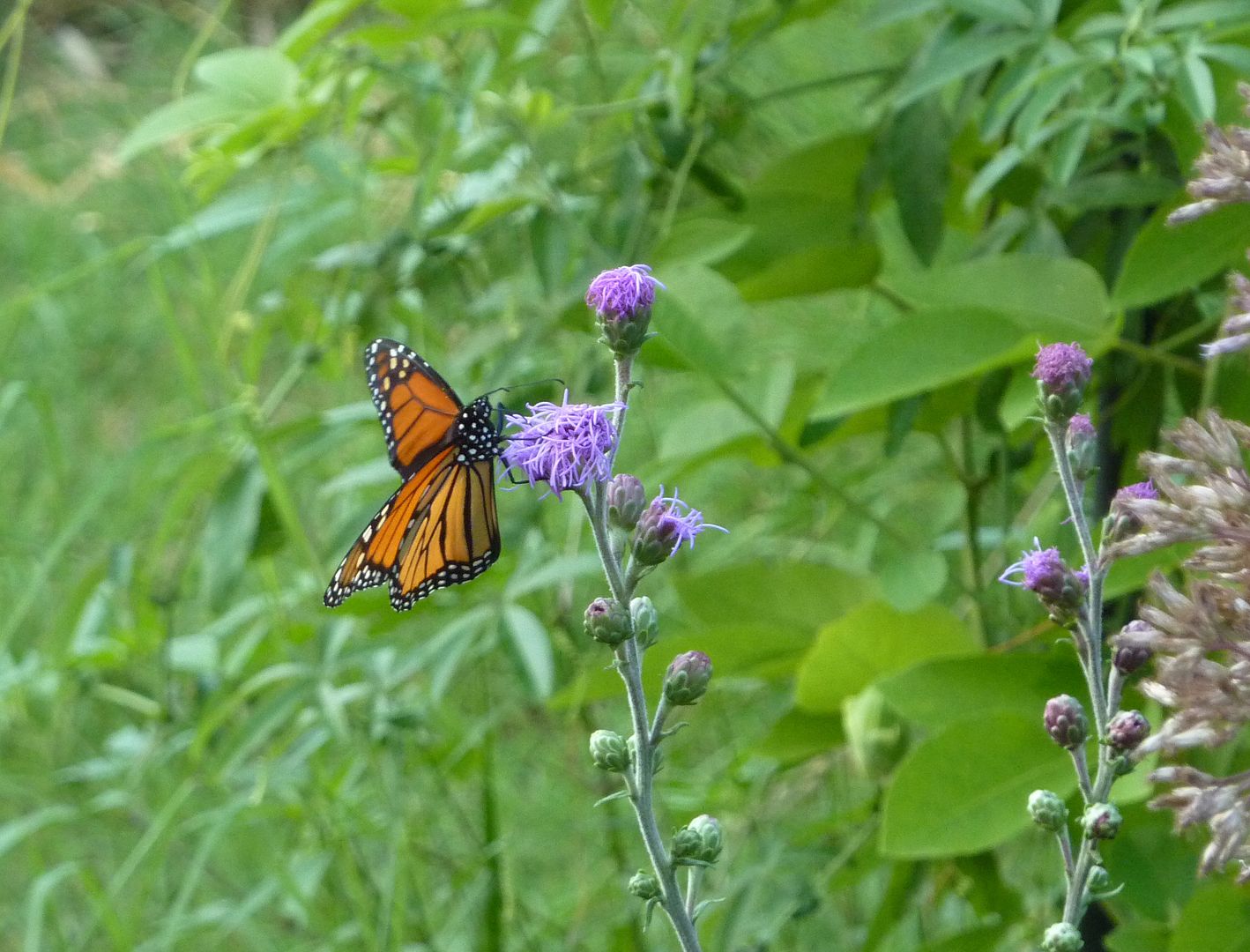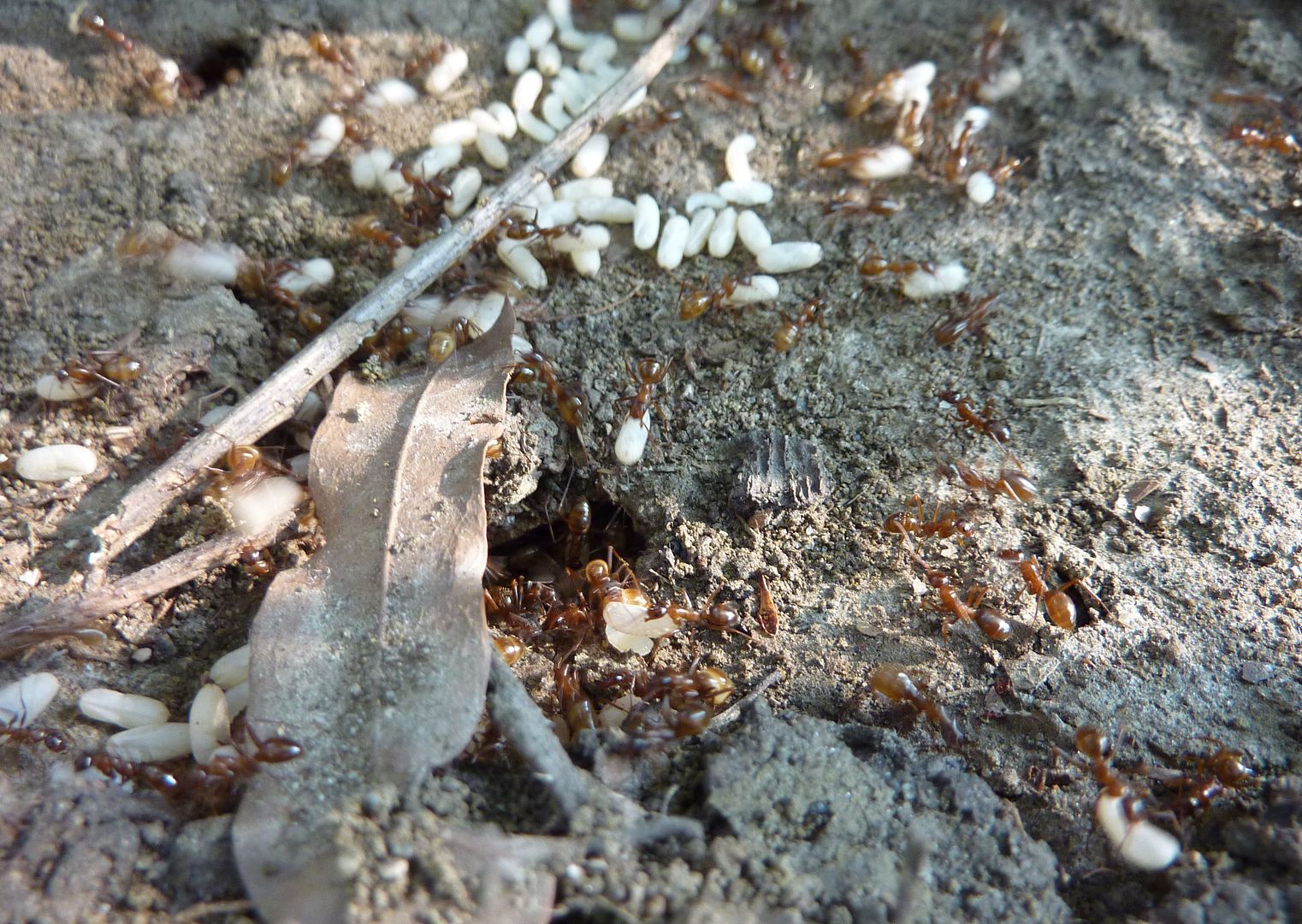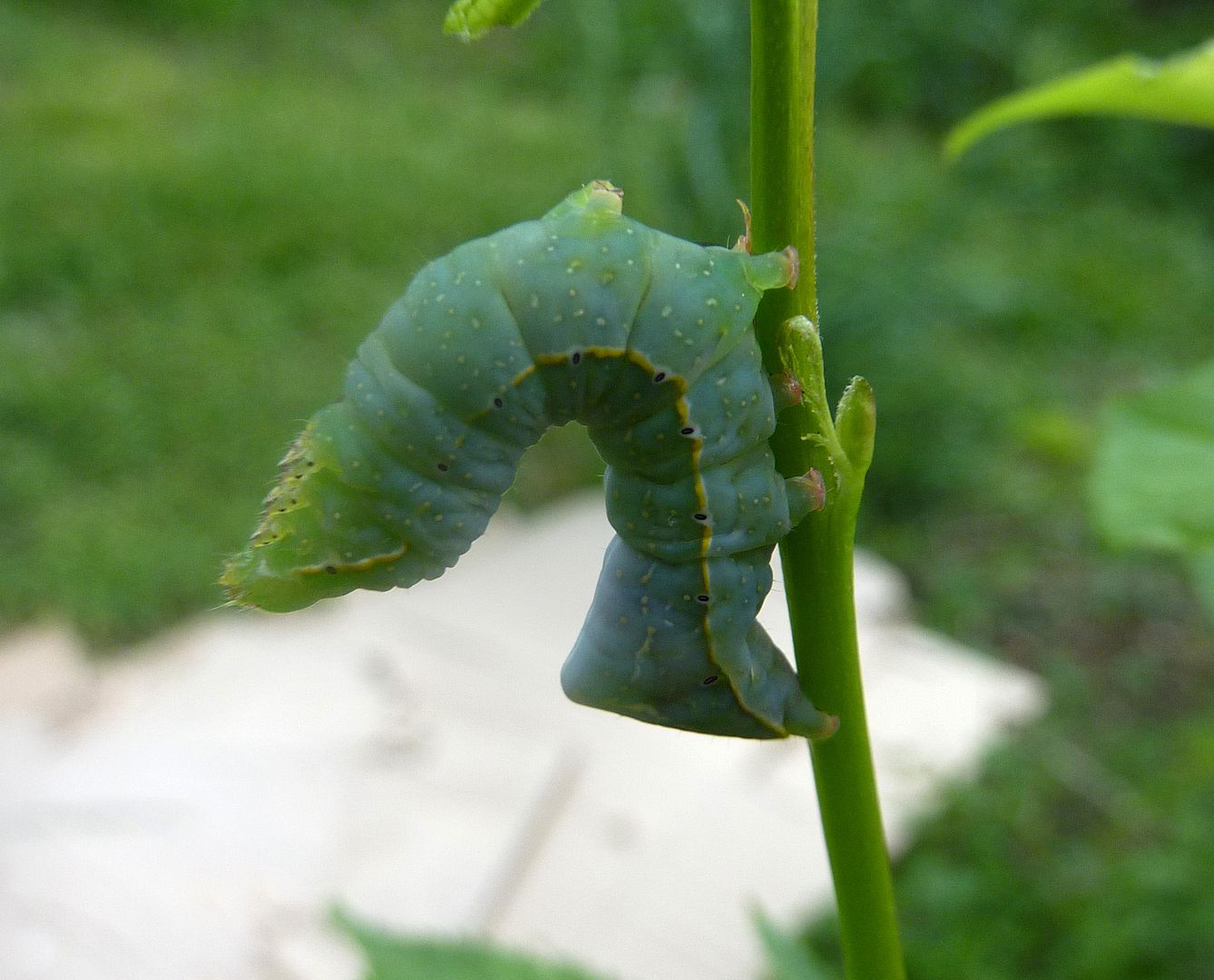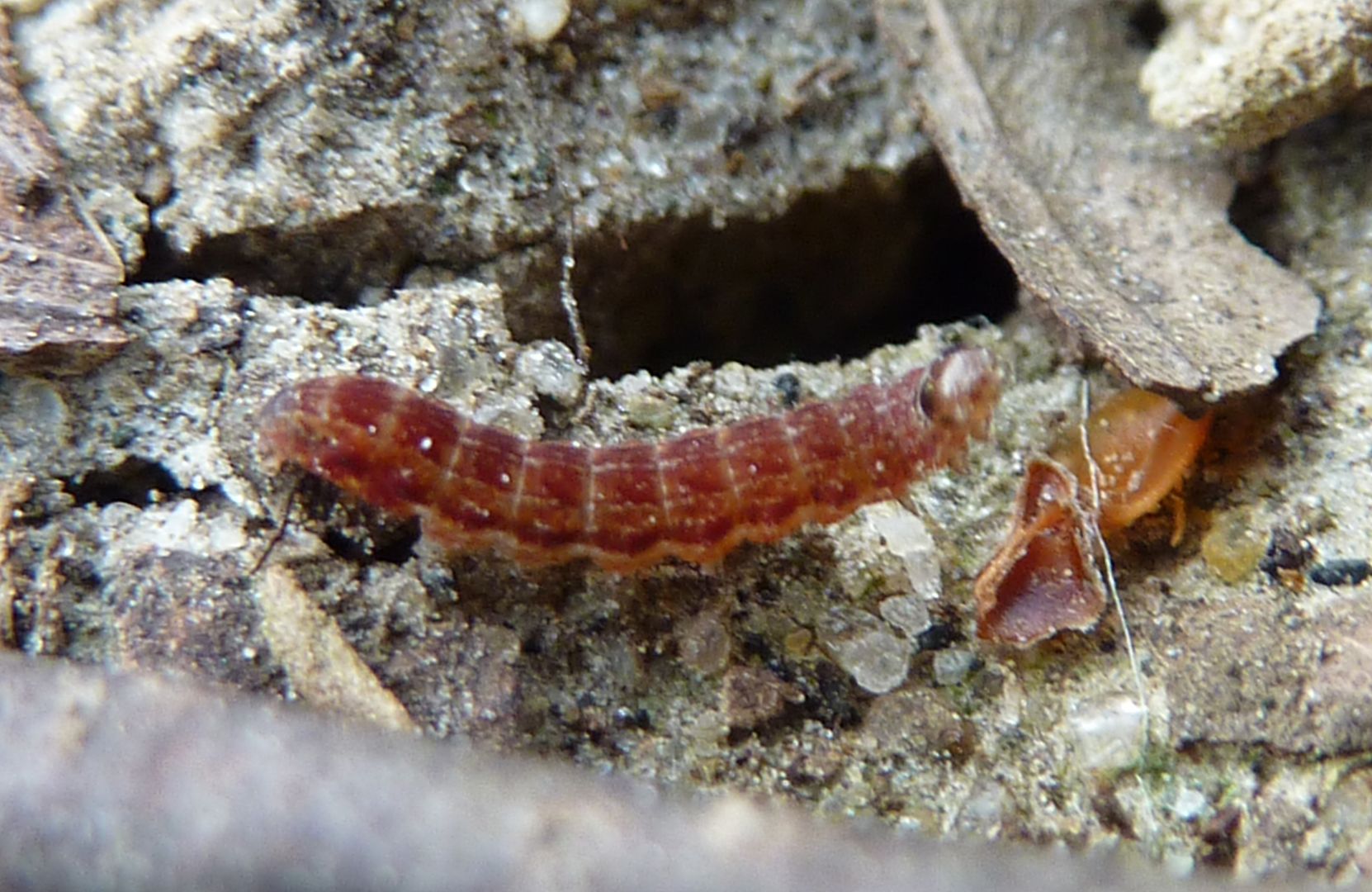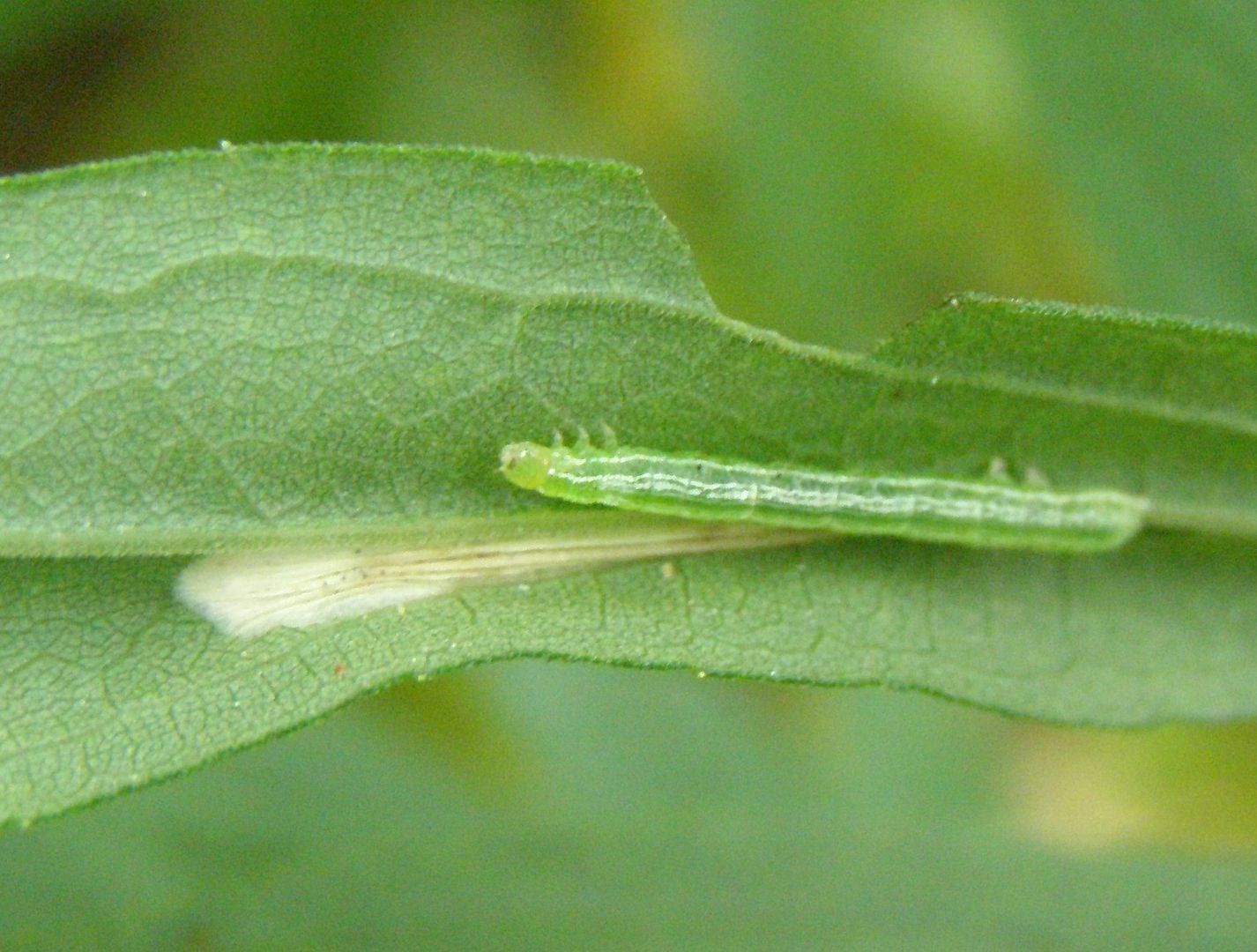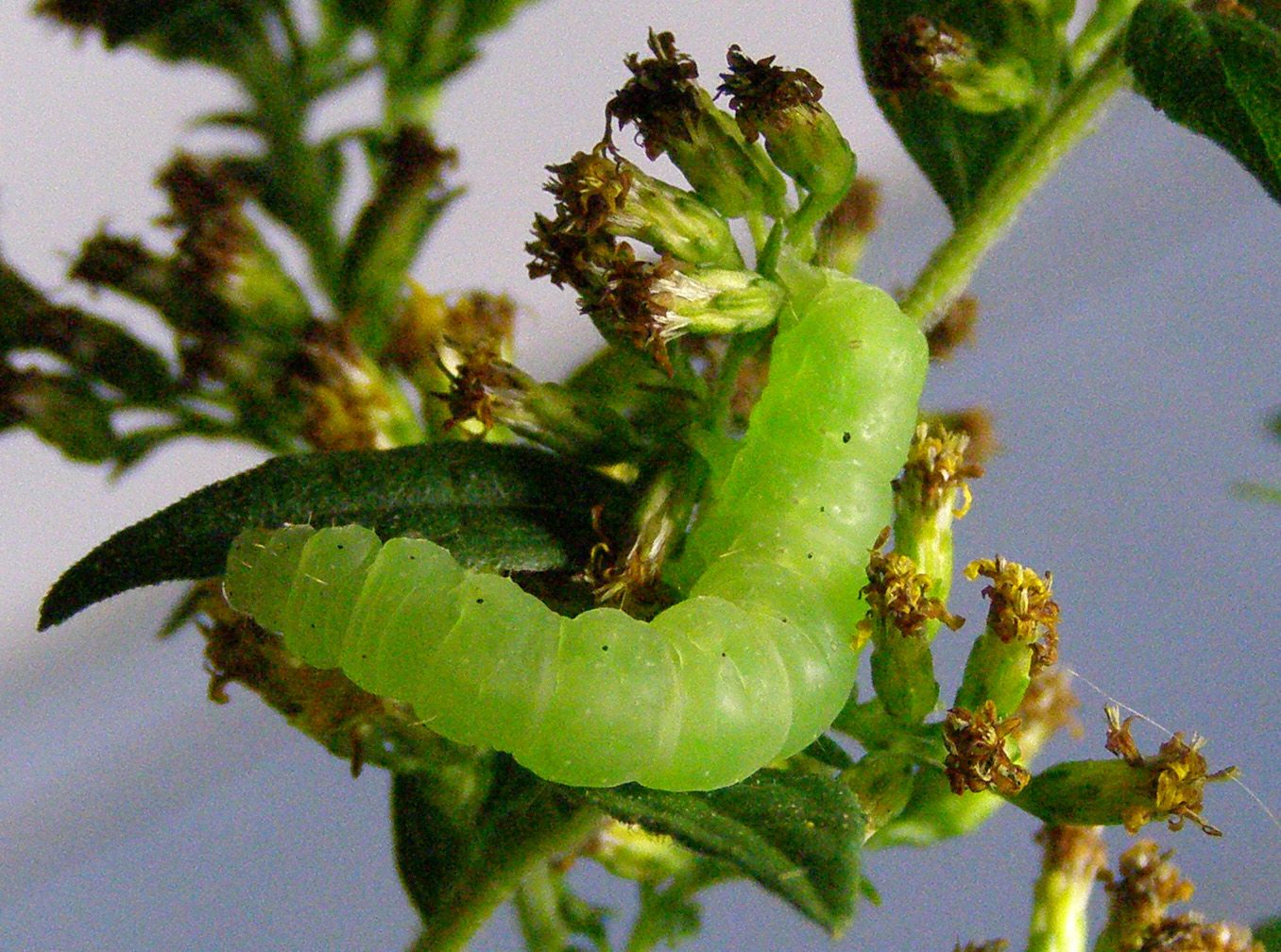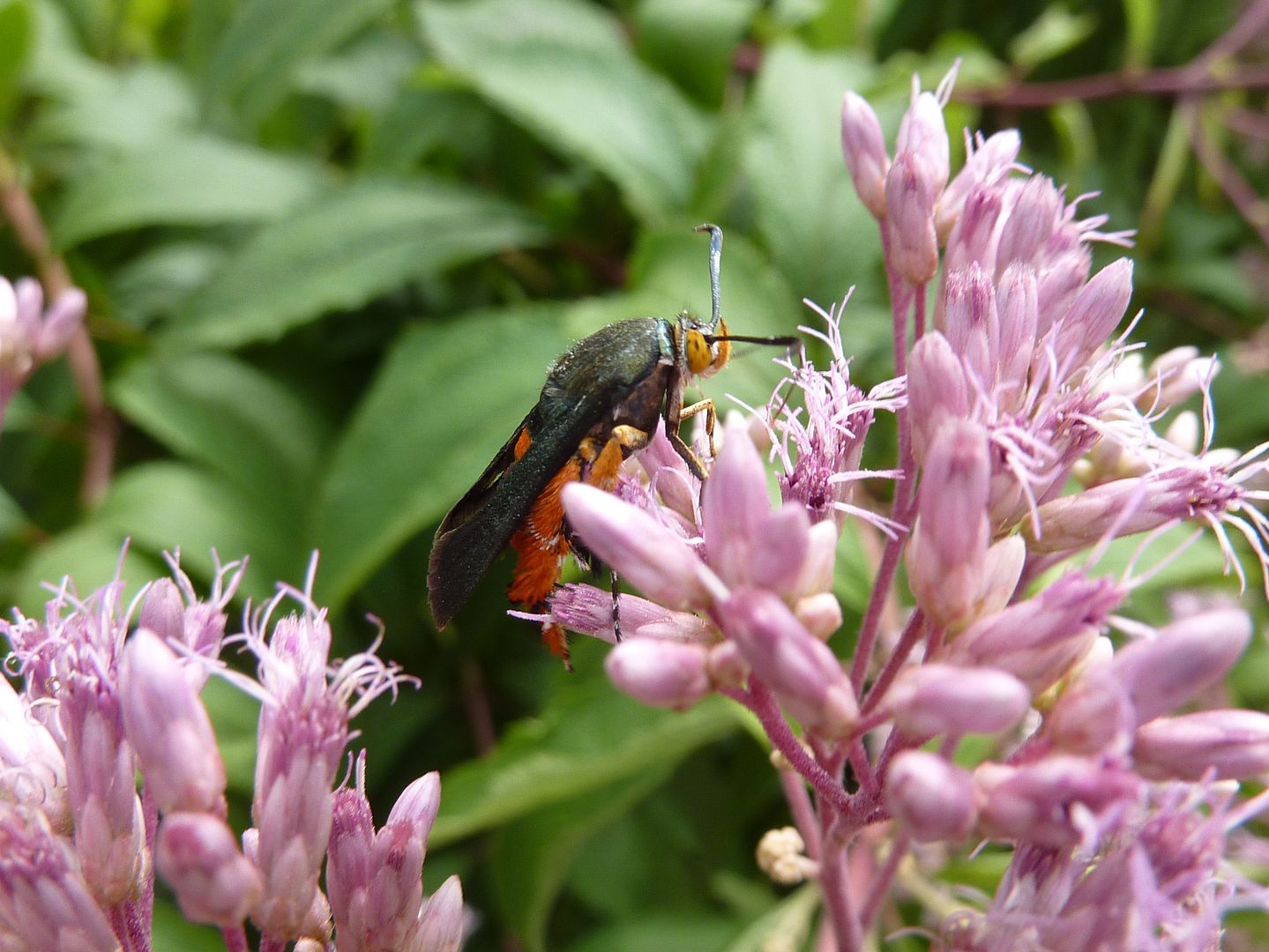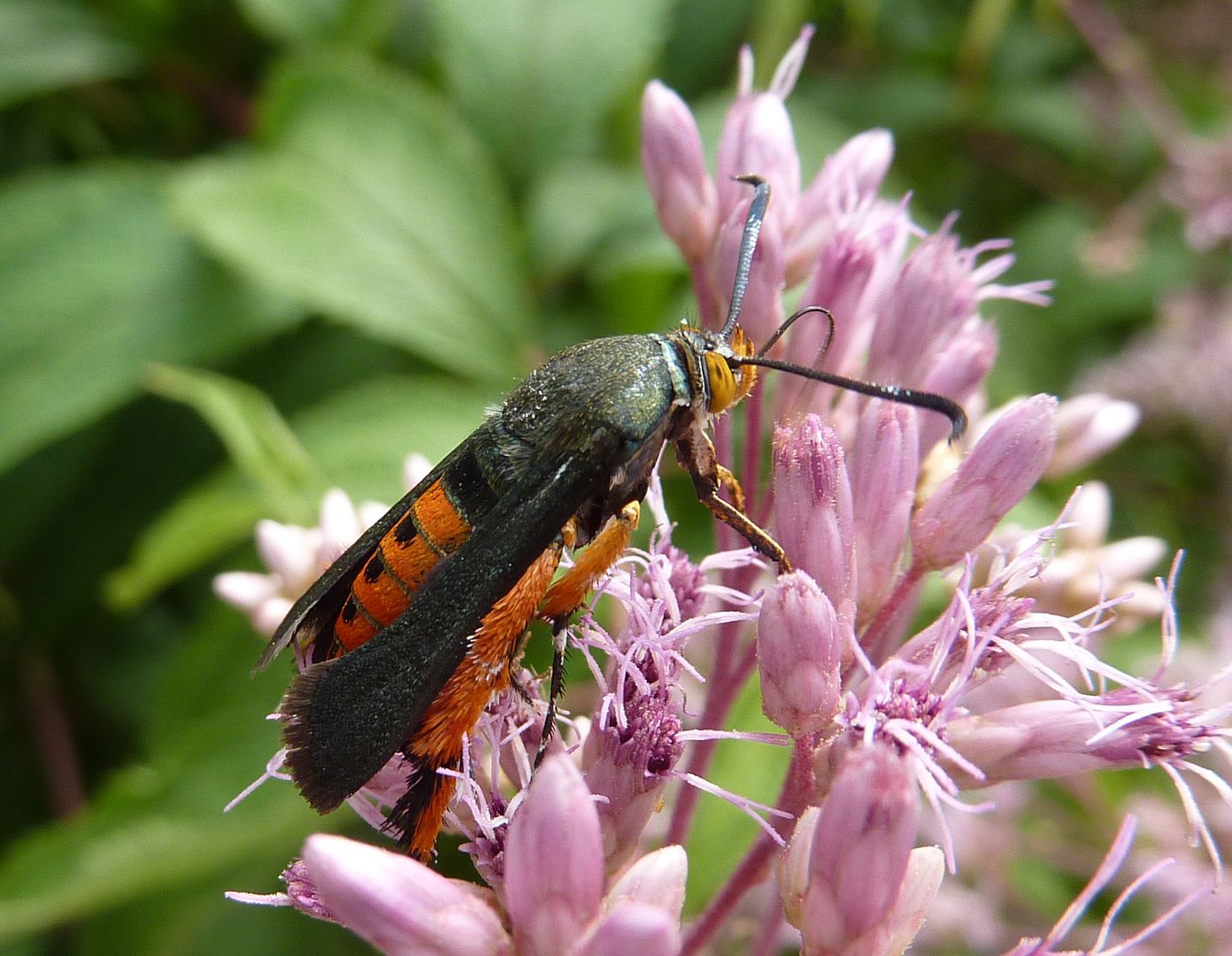Of these three passionflowers only one is native to the US. Take a moment and see if you can guess which. You're options are Purple, Blue, or Red. The two nonnatives are commonly sold at nurseries as annuals. This might be one case where that's a good thing. As far as I can tell all Passiflora species are noxious weeds. They come up all over the place by root suckers and tangle around existing trees, shrubs and fences. That includes the native one too.
What makes this worth growing though is that they're fruiting vines. Growing them up a latices or series of polls surrounded by regularly mowed lawn can help keep them under control. Otherwise weeding will be needed. Passion fruit is sold with some frequency in stores. I've never tasted it myself but I'm told it's similar to Hawaiian Punch... which it is also used to flavor. Though oddly enough it's illegal to import any plant from this genus to Hawaii.
The answer to the question is just one paragraph away. Place your final guesses now.
Growing into a massive vine might actually be a strategy to help pollination. The flowers are so intricate in design that they require the anthers to curl down onto the bee's back while working. From there the pollen has to brush up against stigma to another flower to another plant. This isn't commonly done though so growing into a monster of a vine loaded with flowers helps the plant become a better sources. Hand pollinating with a small paint brush or your finger also works.
If you said Blue or Red, you guessed wrong. The correct answer was Purple, and in my opinion this is also the showiest.
This is Passiflora incarnata, aka Maypop. I got mine from a women just 20 minutes south of where I am. She had it growing in full sun, in loose sandy soil, and boy was it taking over. She had root suckers tangling their way up the goldenrod she'd planted, and it was coming up all over. She was more than happy to give me some.
You may notice that New Jersey (where I live) isn't in it's native range. For food plants I make the exception to plant nonnatives. There are so many weeds in this country that are completely edible but because we're not a starving nation so they go unchecked. Imagen if apple trees were invasive how easily that problem would be solved. I'll also point out that various butterflies that use this plant as a host are found occasionally well beyond it's range. See Gulf Fritillary.
The flowers are unfortunately short lived. I believe they only open for a day (two tops) and that's it, they're done.
The anthers and tips of the stigma are nicely spotted too. This is a fine detail you don't see in to many of our natives.
Here, some type of small bee or fly is stealing nectar. Pollination requires the attention of much larger bees.
To learn more about Maypop, here's a video from Green Dean. Eat The Weeds is such a wonderful series and the world is better for having it.
Tuesday, August 31, 2010
Friday, August 27, 2010
Monarch Surprise
I found this alongside our house. The nearest patch of milkweed is a good 20 feet away. It seems after they've reached the last instar, adult caterpillars will abandon the host plant and make their chrysalis elsewhere. A few of course do stay on the plant but I've found this to be uncommon, (though not rare).
It hangs here like a fine piece of jewelry.
Note the wonderful shade of green accented by the black and gold trim.
A ring of gold spots circles the bottom. I can't help but think their function is only to look beautiful.
It hangs here like a fine piece of jewelry.
Note the wonderful shade of green accented by the black and gold trim.
A ring of gold spots circles the bottom. I can't help but think their function is only to look beautiful.
Tuesday, August 24, 2010
They're Growing
They sure have taken to eating now. A few however have died though. I attribute this to finding a preference for one host plant over the other.
They've started changing color too.
As a side note last night I had a dream where flesh eating caterpillars were nibbling away the skin between my fingers and were disguised as the very scab tissue the horn on their head created upon poking the flesh. Talk about scientific horror.
They've started changing color too.
As a side note last night I had a dream where flesh eating caterpillars were nibbling away the skin between my fingers and were disguised as the very scab tissue the horn on their head created upon poking the flesh. Talk about scientific horror.
Monday, August 23, 2010
Monarch Chrysalis
Not only is it a Chrysalis but it's trimmed with gold. I haven't seen really any Monarchs this year. And I'm surprised to see caterpillars and chrysalises showing up in the milkweed patch.
Here a caterpillar is nibbling the main stem to the leaf. This cuts off the main flow of milky sap that milkweeds get their name for. When the sap hits the air it instantly coagulates into a sticky slime. The sap is sticky enough to kill or glue shut the mouth parts of young caterpillars nibbling on it. Older caterpillars don't have that issue but take this precaution all the same.
Here a caterpillar is nibbling the main stem to the leaf. This cuts off the main flow of milky sap that milkweeds get their name for. When the sap hits the air it instantly coagulates into a sticky slime. The sap is sticky enough to kill or glue shut the mouth parts of young caterpillars nibbling on it. Older caterpillars don't have that issue but take this precaution all the same.
Sunday, August 22, 2010
Polyphemus Caterpillars Hatched
I came home from the wedding last night to find my plastic box of Polyphemus eggs have started hatching. Unlike Monarchs that take 3 days to hatch Polyphemus caterpillars seem to take 10 to 15 days.
I was worried at first because they weren't eating at all. I wend down the list of host plants I have out in my yard and they didn't eat any of the leaves. I'm happy to see today though they have started nibbling. What I believe is Swamp Oak was the winner. Other plants I tried were Willow Oak, Sugar Maple, Button Bush, Crab Apple, Gala Apple, and a native Dogwood. The Willow Oak and Dogwood are getting nibbled too.
They're in the plastic box because they're tiny, and early on they like to wonder. As you saw in the top picture they're covered in hairs and spines that help make them inedible. Despite this though birds still eat them. So it's better if they're spread out on a tree instead of all on the same branch.
They're taking to crowding okay for now. I plan to move them all to a larger terrarium after a few instars, problems pending. I'll have to do this anyhow assuming all 80 of them hatch and grow.
I notice a few have horns but I'm not certain of their purpose yet.
I was worried at first because they weren't eating at all. I wend down the list of host plants I have out in my yard and they didn't eat any of the leaves. I'm happy to see today though they have started nibbling. What I believe is Swamp Oak was the winner. Other plants I tried were Willow Oak, Sugar Maple, Button Bush, Crab Apple, Gala Apple, and a native Dogwood. The Willow Oak and Dogwood are getting nibbled too.
They're in the plastic box because they're tiny, and early on they like to wonder. As you saw in the top picture they're covered in hairs and spines that help make them inedible. Despite this though birds still eat them. So it's better if they're spread out on a tree instead of all on the same branch.
They're taking to crowding okay for now. I plan to move them all to a larger terrarium after a few instars, problems pending. I'll have to do this anyhow assuming all 80 of them hatch and grow.
I notice a few have horns but I'm not certain of their purpose yet.
Friday, August 20, 2010
Busy Weekend
I have to get ready for a wedding this weekend so I probably won't have time to post anything. So I'll take this time to announce that my blog will be getting Pages. The focus will be on ants, identifying them, their anatomy, and mating seasons, etc.... But that will all have to wait until I have some free time.
Wednesday, August 18, 2010
Monarch Caterpillar Time
The garden is getting a little ahead of myself. On the first of August we saw our first Monarch butterfly laying eggs on the milkweed. The eggs typically take 3 days to hatch and the resulting caterpillars are barely bigger than the white dot they hatched out of. So I have no idea how I missed this one! This picture was taken a week ago and it's clearly a few weeks farther along than it should be. Not that I'm complaining of course. I'm marveling over how easy something that big is to miss.
Monday, August 16, 2010
Formica pallidefulva at an Angle
Saturday, August 14, 2010
Polyphemus Moth Eggs
Well I've since let the Polyphemus moth go.
Though now moth-less I'm left with some 80 eggs or so to potentially make more with. I love how they look like little seashells.
Though now moth-less I'm left with some 80 eggs or so to potentially make more with. I love how they look like little seashells.
Friday, August 13, 2010
Found a Polyphemus Moth
Last night while leaving work I discovered a Polyphemus Moth. Actually I discovered two but the other one was scurrying away up the wall. It was the kind of situation I feel where had I been a half hour earlier I probably would have discovered the two mating.
Acting on impulse, I once again put a giant silk moth in the car as I drove home to take pictures. The last time I did this it was with a Luna Moth and the damn thing flew up on my nose while driving! Had I been in an accident I'd have smashed the thing to my face against the air bag leaving paramedics to wonder why I was wearing a cabaret mask.
Thankfully the Polyphemus moth was more cooperative. And what's more, upon getting home I reached down between the driver's side door and driver seat. Apparently Big Moth-e wants Out-e. I discovered she had started laying eggs!
I have read that if you put them in a "paper bag" over night they'll deposit some eggs. Well apparently it's not so much the texture of the bag as the moth naturally reacting to complete darkness! So I put her in a box for the night and sure enough she laid eggs.
I'll be letting her go later tonight just as it gets dark. My yard is after all full of host plants for her though I do wish I had some Birch trees. Apple, Maple, Ash, and according to Doug Tallamy, Button Bush are all used as host plants. Now that I have a few dozen eggs to toy around with I'm thinking I'll try and rear some caterpillars if they hatch. I do have the leaves for this after all. I'm just not sure what to do about winter. hmmm.
Acting on impulse, I once again put a giant silk moth in the car as I drove home to take pictures. The last time I did this it was with a Luna Moth and the damn thing flew up on my nose while driving! Had I been in an accident I'd have smashed the thing to my face against the air bag leaving paramedics to wonder why I was wearing a cabaret mask.
Thankfully the Polyphemus moth was more cooperative. And what's more, upon getting home I reached down between the driver's side door and driver seat. Apparently Big Moth-e wants Out-e. I discovered she had started laying eggs!
I have read that if you put them in a "paper bag" over night they'll deposit some eggs. Well apparently it's not so much the texture of the bag as the moth naturally reacting to complete darkness! So I put her in a box for the night and sure enough she laid eggs.
I'll be letting her go later tonight just as it gets dark. My yard is after all full of host plants for her though I do wish I had some Birch trees. Apple, Maple, Ash, and according to Doug Tallamy, Button Bush are all used as host plants. Now that I have a few dozen eggs to toy around with I'm thinking I'll try and rear some caterpillars if they hatch. I do have the leaves for this after all. I'm just not sure what to do about winter. hmmm.
Thursday, August 12, 2010
Host Plant Lists
As posted in a topic over at the Wildlife Gardener's Forum I fell it's worth posting this here. Two things happened all at once. Basically over the past week I realized that the host plants for some Brushfoot Butterflies (Fritillary, Red Admiral, American and Painted Lady etc...) over lap and make a fairly good garden idea. What started as a New England Aster with Pussytoe growing as a ground cover around it turned into a full on list and Brushfoot Butterfly Garden.
Basically I went through the pages "Caterpillars of Eastern North America" and wrote down all the host plants to various groups of butterflies. For some groups it works better than others though. Ones like Mourning Cloak and the Tiger Swallowtail almost whore themselves to the forest. Generally if you have any native hardwood tree in your yard, particularly: Oak, Maple, Willow, Wild Cherry/Native Plum, or Apple you have a host plant that they'll use. The issue though is Mourning Cloaks prefer a full shade forest setting and Tiger Swallowtails are more open forest edge flying.
The second thing that happened was a topic on Bluestone Perennials. Not to pick on them in particular but if you go to their site and click on "Plants that Attract Butterflies" you'll find that just about every flowering plant known to man attracts butterflies. Yes that's right, apparently fine choices like the Pasque flower, which is basically a native Crocus is a great choice for a butterfly plant. Sure it flowers just as the snow melts off the darn thing but the butterflies just can't resist.
Basically the garden industries idea of Butterfly Plants is another way of saying Pollinator Plants. I'm not going to say the Pasque flower doesn't get butterflies on it but frankly anything in the adult stage when the Pasque flower blooms will more than likely be interested in an Azalia or Native Honeysuckle which bloom way heavier for that time of year. Just looking at all the anthers in the Pasque flower tells me it's intended for bees. Butterfly flowers tend to grow in either mats or have reasonably tube or small trumpet shaped flowers, such as mint.
But it can't all be about nectar. So often so called "Butterfly Gardens" engage in the absolute most frilly nectar plants around. A good test to judge what kind of butterfly gardener someone is, is showing them the life cycle of the Tiger Swallowtail. First show them the adult stage. Next show them the caterpillar stage, with emphases on the 1st, 2ed, and 3ed instar when the caterpillar mimics a clump of bird shit best. A true butterfly gardener will appreciate how a clump of bird shit turns into such a majestic looking winged insect. Everyone else is just a poser.
Host Plants For Brushfoots (Fritillary, Red Admirals, American and Painted Ladies etc...)
Hops (vine)
Passion-flower (vine)
Nettle
Pussytoe
Lupine
Violets
May Apple
Asters
Turtle Head (white flowering I hear is best)
False Foxglove (yellow flowering I hear is best)
Milkweed
And having a Hackberry tree around helps as it's host to two species.
Besides the Hackberry all of these are perennials easily planted together in any garden.
Host Plants For Whites and Sulphurs
Brassicaceas (surprisingly I read this includes ornamental cabbage.)
Wild Senna
Indigo Bush
Lead Plant
Prairie Clover
Lupin and other Legumes
Cassias? which I think only grows in Florida.
Again all good plants for the garden. Though many people don't like having Whites because they eat cabbage and related plants, I think the Sulphurs are a missed jewel of the garden.
Host Plants For Swallowtails
Pipe Vine (vine)
Carrot Family (Golden Alexander, Parsley, Carrots etc...)
Spice Bush/Sassafras
Paw Paw, (and other Custard Apple Family?)
Native Magnolia, Tulip Tree, Wild Cherry, Apple ect...
Alright Swallowtails are the big boys in the butterfly garden, and it stands to reason most of their host plants are woody perennials and trees.
I could have gone farther with Hummingbird Moths, and Giant Silk Moths and so on but these are most of the pretty ones.
Basically I went through the pages "Caterpillars of Eastern North America" and wrote down all the host plants to various groups of butterflies. For some groups it works better than others though. Ones like Mourning Cloak and the Tiger Swallowtail almost whore themselves to the forest. Generally if you have any native hardwood tree in your yard, particularly: Oak, Maple, Willow, Wild Cherry/Native Plum, or Apple you have a host plant that they'll use. The issue though is Mourning Cloaks prefer a full shade forest setting and Tiger Swallowtails are more open forest edge flying.
The second thing that happened was a topic on Bluestone Perennials. Not to pick on them in particular but if you go to their site and click on "Plants that Attract Butterflies" you'll find that just about every flowering plant known to man attracts butterflies. Yes that's right, apparently fine choices like the Pasque flower, which is basically a native Crocus is a great choice for a butterfly plant. Sure it flowers just as the snow melts off the darn thing but the butterflies just can't resist.
Basically the garden industries idea of Butterfly Plants is another way of saying Pollinator Plants. I'm not going to say the Pasque flower doesn't get butterflies on it but frankly anything in the adult stage when the Pasque flower blooms will more than likely be interested in an Azalia or Native Honeysuckle which bloom way heavier for that time of year. Just looking at all the anthers in the Pasque flower tells me it's intended for bees. Butterfly flowers tend to grow in either mats or have reasonably tube or small trumpet shaped flowers, such as mint.
But it can't all be about nectar. So often so called "Butterfly Gardens" engage in the absolute most frilly nectar plants around. A good test to judge what kind of butterfly gardener someone is, is showing them the life cycle of the Tiger Swallowtail. First show them the adult stage. Next show them the caterpillar stage, with emphases on the 1st, 2ed, and 3ed instar when the caterpillar mimics a clump of bird shit best. A true butterfly gardener will appreciate how a clump of bird shit turns into such a majestic looking winged insect. Everyone else is just a poser.
Host Plants For Brushfoots (Fritillary, Red Admirals, American and Painted Ladies etc...)
Hops (vine)
Passion-flower (vine)
Nettle
Pussytoe
Lupine
Violets
May Apple
Asters
Turtle Head (white flowering I hear is best)
False Foxglove (yellow flowering I hear is best)
Milkweed
And having a Hackberry tree around helps as it's host to two species.
Besides the Hackberry all of these are perennials easily planted together in any garden.
Host Plants For Whites and Sulphurs
Brassicaceas (surprisingly I read this includes ornamental cabbage.)
Wild Senna
Indigo Bush
Lead Plant
Prairie Clover
Lupin and other Legumes
Cassias? which I think only grows in Florida.
Again all good plants for the garden. Though many people don't like having Whites because they eat cabbage and related plants, I think the Sulphurs are a missed jewel of the garden.
Host Plants For Swallowtails
Pipe Vine (vine)
Carrot Family (Golden Alexander, Parsley, Carrots etc...)
Spice Bush/Sassafras
Paw Paw, (and other Custard Apple Family?)
Native Magnolia, Tulip Tree, Wild Cherry, Apple ect...
Alright Swallowtails are the big boys in the butterfly garden, and it stands to reason most of their host plants are woody perennials and trees.
I could have gone farther with Hummingbird Moths, and Giant Silk Moths and so on but these are most of the pretty ones.
Labels:
Lepidoptera,
List,
native,
Plants
Tuesday, August 10, 2010
What If Tulips?
Sorry for this short post but I just had a conversation with a friend about true species of Tulips. Supposedly true species actually produce nectar and pollen and get pollinates but that's not what interested me. Tulipa turkestanica has a striking resemblance to Erythronium americcanum, and E. albidum. Clearly these are two separate genera but it's the kind of thing that makes me think. How different would our landscapes be if cultivating spring wildflowers had started in North America instead of Europe. Who knows, maybe with some stretch of selective breeding we could one day see a very Tulip-like wildflower on the market derived from Erythronium instead of Tulipa.
Monday, August 9, 2010
First Monarch of the Year
Got my first Monarch butterfly of the season today. I don't know what it is about my part of New Jersey. We don't see Monarchs here ever until August, while everyone else I know in the state sees them in May/June. I think it's because the primary migration up north fallows the coast line and they cross the Delaware River early on.
Liatris ligulistylis was the big winner again. It blooms just as the Joe Pye Weed, seen in the back, finished it's bloom. I bought loads of this Liatris this year from Prairie Moon Nursery but I believe greenhouse conditions stunted their growth or triggered them all to go into shock or something. Better luck next year I guess. Thankfully the one from last year came back and bloomed again. Another one that had been dormant last year also came up and has bloomed. Note the black spot on the middle of the hind wing; this was a male.
He spent a good amount of time on this plant. Every time I scared him away he'd circle the yard then eventually come back. I was surprised to see he didn't go for the Cup Plant as all the Tiger Swallowtails are going for.
In the future populations of butterflies and the foods they go for will be neat to observe. Milkweed for the Monarch was the first host plant I installed and clearly they like late blooming Liatris, and New England Asters. Tiger Swallowtails already have established host plants only a few houses away. My neighbor has a huge Tulip Tree in their yard and behind my garden another neighbor has a Black Cherry Tree which are both host plants (I think). They come into the yard to forage and I never get to see the caterpillar stage.
Other host plants I'm still establishing are Spice Bush, Pipe Vine, Wild Senna, and Paw Paw. I have Golden Alexander too which is in the Carrot Family but have never seen the caterpillar it attracts. These will one day attract the Spice Bush Swallowtail, Pipe Vine Swallowtail, Zebra Swallowtail, Black Swallowtail, and Cloudless Sulphur. And then of course there's the Red Spotted Purple but it's host plants range from Apple, Ash, Willow and are on par with Tiger Swallowtail for me, with to many tall trees in it's host pallet. I have a few of them but it's such a broad range of tall trees it's more a matter of being in the area or not. Many of these over winter in the pupa stage and hatch out in the spring as adults while others are migratory and have seasons like the Monarch.
Liatris ligulistylis was the big winner again. It blooms just as the Joe Pye Weed, seen in the back, finished it's bloom. I bought loads of this Liatris this year from Prairie Moon Nursery but I believe greenhouse conditions stunted their growth or triggered them all to go into shock or something. Better luck next year I guess. Thankfully the one from last year came back and bloomed again. Another one that had been dormant last year also came up and has bloomed. Note the black spot on the middle of the hind wing; this was a male.
He spent a good amount of time on this plant. Every time I scared him away he'd circle the yard then eventually come back. I was surprised to see he didn't go for the Cup Plant as all the Tiger Swallowtails are going for.
In the future populations of butterflies and the foods they go for will be neat to observe. Milkweed for the Monarch was the first host plant I installed and clearly they like late blooming Liatris, and New England Asters. Tiger Swallowtails already have established host plants only a few houses away. My neighbor has a huge Tulip Tree in their yard and behind my garden another neighbor has a Black Cherry Tree which are both host plants (I think). They come into the yard to forage and I never get to see the caterpillar stage.
Other host plants I'm still establishing are Spice Bush, Pipe Vine, Wild Senna, and Paw Paw. I have Golden Alexander too which is in the Carrot Family but have never seen the caterpillar it attracts. These will one day attract the Spice Bush Swallowtail, Pipe Vine Swallowtail, Zebra Swallowtail, Black Swallowtail, and Cloudless Sulphur. And then of course there's the Red Spotted Purple but it's host plants range from Apple, Ash, Willow and are on par with Tiger Swallowtail for me, with to many tall trees in it's host pallet. I have a few of them but it's such a broad range of tall trees it's more a matter of being in the area or not. Many of these over winter in the pupa stage and hatch out in the spring as adults while others are migratory and have seasons like the Monarch.
Saturday, August 7, 2010
Formica Recovering
Just barely a month ago I had a colony of slave making Formica pergandei raid a colony of either Formica pallidefulva, or F. incerta. I haven't studied up on either enough to tell them apart. Well the slave makers about a week later left the nest bare. They'd packed up all the slaves, all the brood, and all their colony members. I'm uncertain if this was a raiding party or the whole colony of F. pergandei. But anyhow you can read about that exploit here and see videos of them in the last third of Ant Chat Episode 22 (also available ad-free on iTunes).
Well to my surprise I went back to where the colony was and found another colony of Formica pallidefulva or incerta has moved on in.
That didn't take long, and without a slave maker to be seen. I've found this species normally has multiple queens and colonies divide and combine as needed over the year. Over the summer months they stay separated more while resources are low, but now that I think about it this is also the time when slave making Formica (and Polyergus) start their raids on Formic colonies. It's almost as though the Formica host species have evolved a tactic to hopefully avoid confrontation.
Presumably though they are able to maintain healthy colonies through effective foraging habits. Naturally the more food available, the more Formica colonies an area can handle. Here you can see not only has the colony moved in but they've caught a tasty worm.
Considering my native plant garden is loaded with caterpillars, the only thing really competing against the Formica colonies in the day (and Camponotus colonies at night) are wasps. Lots of pictures of caterpillars from my yard are featured here in an old post from last year, but here are some reposts from this year.
And for those of you up north, keep an eye out for this one on Milkweed plants. It's the caterpillar form to the Monarch Butterfly.
Well to my surprise I went back to where the colony was and found another colony of Formica pallidefulva or incerta has moved on in.
That didn't take long, and without a slave maker to be seen. I've found this species normally has multiple queens and colonies divide and combine as needed over the year. Over the summer months they stay separated more while resources are low, but now that I think about it this is also the time when slave making Formica (and Polyergus) start their raids on Formic colonies. It's almost as though the Formica host species have evolved a tactic to hopefully avoid confrontation.
Presumably though they are able to maintain healthy colonies through effective foraging habits. Naturally the more food available, the more Formica colonies an area can handle. Here you can see not only has the colony moved in but they've caught a tasty worm.
Considering my native plant garden is loaded with caterpillars, the only thing really competing against the Formica colonies in the day (and Camponotus colonies at night) are wasps. Lots of pictures of caterpillars from my yard are featured here in an old post from last year, but here are some reposts from this year.
And for those of you up north, keep an eye out for this one on Milkweed plants. It's the caterpillar form to the Monarch Butterfly.
Friday, August 6, 2010
Wednesday, August 4, 2010
Sting like a Butterfly
I'm rolling my eyes at the little pop up window advertising some stupid shop at home alert or something. As if someone with a computer doesn't already know how to shop on the internet. I do apologize for those ads.
I see the All Asian one is becoming slightly more English I guess that's an improvement.
So I stepped outside a few days ago and was greeted by this charming insect. My next question of course was, What is it?
Clearly it's mimicking a wasp... though I've never seen the wasp it's mimicking hmmm. It has the mouth parts of a moth or butterfly, but I've never herd of them to mimic anything. Naturally I wasted time looking through pictures of hundreds of flies over at Bug Guide.
Finally I caught a break with the aid of Alex Wild and Gordon Snelling (I don't think he blogs). Though entomologists, neither knew the exact species but were kind enough to take time out of their busy schedule say it was in fact a Lepidoptera, though among the strangest moth or butterfly that I'd ever seen. Alex had a bit of a head start and was able to tell me a Sesiidae family of some sort, a.k.a. Clearwing Moths.
From here I was able to discover this is the adult form of the Squash Borer, who's host plants ranges from assorted cucumber, pumpkin, gourd, squash etc... Sure enough I found more of these pollinators hanging out on those plants right in the garden.
I see the All Asian one is becoming slightly more English I guess that's an improvement.
So I stepped outside a few days ago and was greeted by this charming insect. My next question of course was, What is it?
Clearly it's mimicking a wasp... though I've never seen the wasp it's mimicking hmmm. It has the mouth parts of a moth or butterfly, but I've never herd of them to mimic anything. Naturally I wasted time looking through pictures of hundreds of flies over at Bug Guide.
Finally I caught a break with the aid of Alex Wild and Gordon Snelling (I don't think he blogs). Though entomologists, neither knew the exact species but were kind enough to take time out of their busy schedule say it was in fact a Lepidoptera, though among the strangest moth or butterfly that I'd ever seen. Alex had a bit of a head start and was able to tell me a Sesiidae family of some sort, a.k.a. Clearwing Moths.
From here I was able to discover this is the adult form of the Squash Borer, who's host plants ranges from assorted cucumber, pumpkin, gourd, squash etc... Sure enough I found more of these pollinators hanging out on those plants right in the garden.
Sunday, August 1, 2010
Falling for Joe Pye Weed
Hollow Stem Joe Pye Weed is one of my favorite plants. But the one thing I hate about it is it can fall over.
Here is a video from two years ago of the same plant just to prove it can stand up and behave.
As you can see it's a good nectar plant. I wish it was slightly more diverse than just honey bees but I won't complain that much especially after harvesting 78 jars (final count) of honey from only two beehives. I usually get a lot of swallowtail butterflies on it too but this year they're going for the Cup Plant, Silphium perfoliatum. If you have a full sun spot I defiantly recommend this plant.
Leaf Cutter Bee Activity
Clear and obvious signs of Leaf Cutter Bees. It's neat how they pick on the Eastern Redbud so much. Chewing out holes from the heart shaped leaves. That said Leaf Cutter Bees are easily spooked and I haven't even seen one out there.
Here is a video (not mine) of how quickly they can cut a leaf.
They nest in both pre drilled holes and in underground burrows. I've noticed they're more active in the summer time unlike most Mason and Mining Bees. Mason Wasps also occur more in the summer time along with the specialized predators such as the Scoliid Wasp.
Here is a video (not mine) of how quickly they can cut a leaf.
They nest in both pre drilled holes and in underground burrows. I've noticed they're more active in the summer time unlike most Mason and Mining Bees. Mason Wasps also occur more in the summer time along with the specialized predators such as the Scoliid Wasp.
Subscribe to:
Posts (Atom)
